List of Psilocybin Mushroom Species (And Other Psychoactive Fungi)
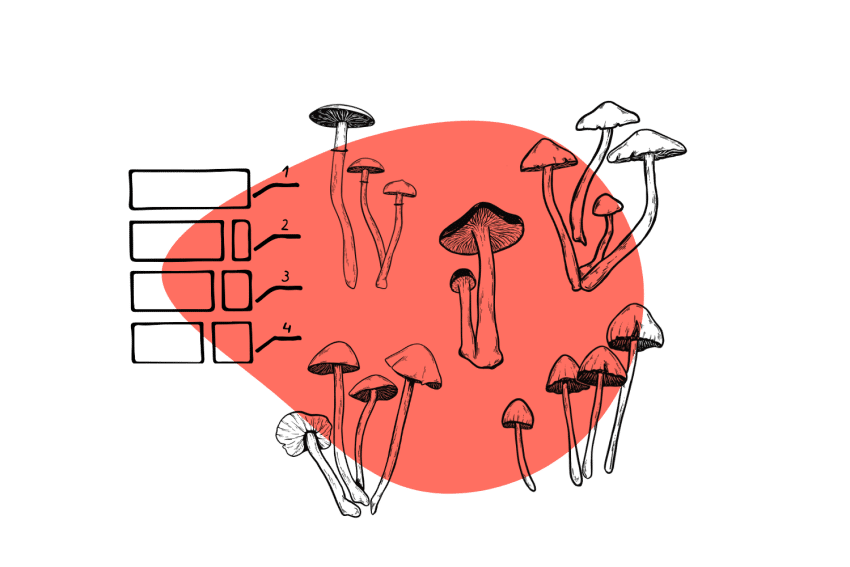
There are more than 180 different species of psychedelic mushrooms.
psilocybin mushroom species are surprisingly common.
Regardless of where you live, there are likely to be magic mushrooms endemic to the area. The downside is that there are plenty of toxic lookalikes too.
Learn about the 2 major and 4 minor genera of psilocybin-containing magic mushrooms — Psilocybe, Panaeolus, Conocybe, Inocybe, Pluteus, and Gymnopilus.
CLICK HERE TO BUY MAGIC MUSHROOM IN THE UK
What’s the Difference Between a psilocybin mushroom species ?
Species refer to a grouping of individual organisms that can reproduce together. For example, all Psilocybe cubensis mushrooms can be bred together to produce offspring, but Psilocybe cubensis and Psilocybe azurescens cannot.
psilocybin mushroom species are subgroups of different phenotypes or growth patterns within a given species. This may include differences in the color, size, and potencies of organisms all contained within the same species.
For example, there are over 100 individual Psilocybe cubensis strains, such as B+ strain, Orissa India, golden teachers, etc. All of these strains have slightly different growth habits and appearances but are all still considered members of the Psilocybe cubensis species.

We can use humans as an analogy. A race is essentially the same as a strain because it refers to a subgroup of people with different characteristics but is still included under the same species (Homo sapiens). A Caucasian person can reproduce just as easily with an Asian as any other human. However, there are clear phenotypic differences between Caucasians and Asians (such as differences in bone structure and skin coloration).
Summary: Top 10 Magic psilocybin mushroom species Ranked By Potency
| Species Name | Psilocybin Content | Psilocin Content | Total Active Ingredients |
| Psilocybe azurescens | 1.78% | 0.38% | 2.16% |
| Psilocybe semilanceata | 0.98% | 0.72% | 1.70% |
| Psilocybe bohemica | 1.34% | 0.11% | 1.45% |
| Psilocybe baeocystis | 0.85% | 0.59% | 1.44% |
| Psilocybe zapotecorum | 0.30% | 1.00% | 1.30% |
| Psilocybe samuiensis | 0.73% | 0.52% | 1.25% |
| Psilocybe cubensis | 0.63% | 0.60% | 1.23% |
| Psilocybe cyanescens | 0.85% | 0.36% | 1.21% |
| Panaeolus cambodginiensis | 0.55% | 0.60% | 1.15% |
| Psilocybe tampanensis | 0.68% | 0.32% | 1.00% |
Psychedelic Fungi Genera
There are nearly 14,000 species of fungi around the world, with new species continuing to be discovered yearly.
A surprising number of these species produce the psychoactive ingredients psilocybin, psilocin, and baeocystin. In the Psilocybe genus alone, nearly 100 species of mushrooms are recognized to contain psychedelic ingredients.
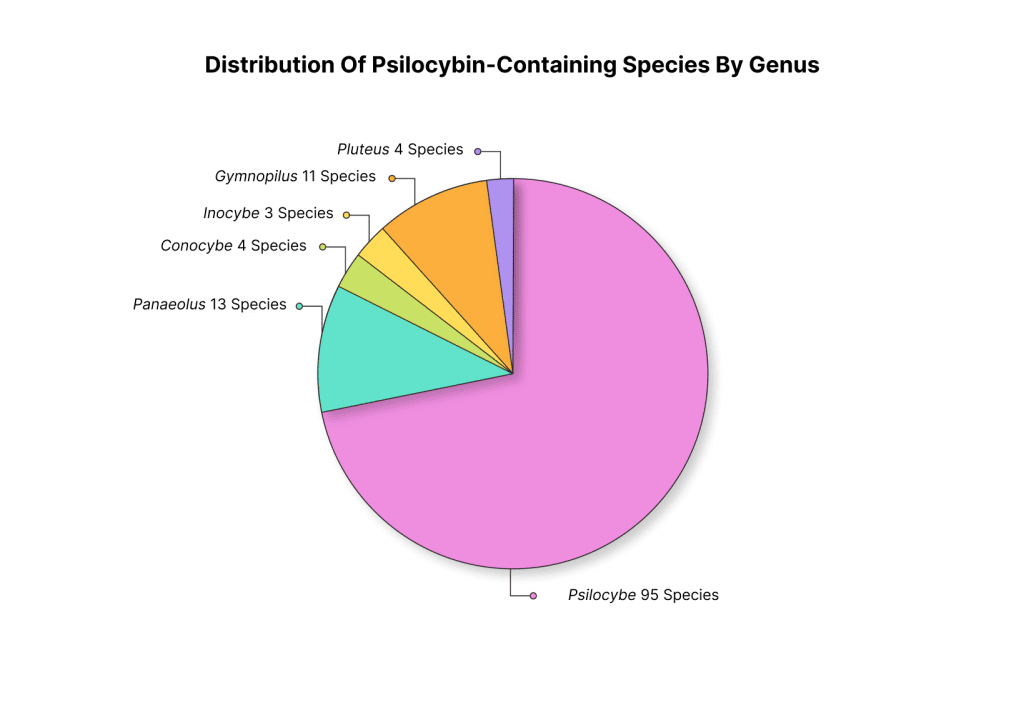
Other species of mushrooms contain separate psychedelic compounds, such as ibotenic acid and muscimol in the Amanita muscaria mushroom — or ergot alkaloids (lysergamides similar to LSD) in the ergot fungus (Claviceps spp.).
Here are the six most prominent psilocybin-containing genera and some of the most notable species within each genus — starting with the leader of the pack, Psilocybe.
1. Psilocybe
The Psilocybe genus contains more than 180 different psilocybin mushroom species . Roughly 95 of these species contain psychoactive doses of psilocybin and psilocin, as well as a closely related compound called baeocystin.
This is, by far, the most common genus of psychedelic mushrooms. They’re easy to grow (most of them), many are powerful psychedelics, and they’re found on virtually every continent on Earth.
The Psilocybe genus is difficult to differentiate between other genera’ such as Hypholoma or Stropharia. Most of the members in these genus’ are described as “little brown mushrooms” or LBMs — which makes identification very difficult.
A key differentiator with psilocybe species is the “blueing reaction” that forms when the mushrooms are touched. After a few minutes, the outside of the mushroom will bruise in a blue color, which is caused by the psilocybin inside the mushrooms. The stronger the psilocybin content, the more dramatic the blueing reaction.
Psilocybe argentipes
This psilocybin mushroom species has only been reported in Japan. It grows alongside trail edges and in wooded areas that contain oak, loblolly pines, or sugi pines.
The specific concentration of psilocybin and psilocin remains a mystery, but people who have taken this mushroom report the potency as comparable to Psilocybe cyanescens or Psilocybe cubensis.
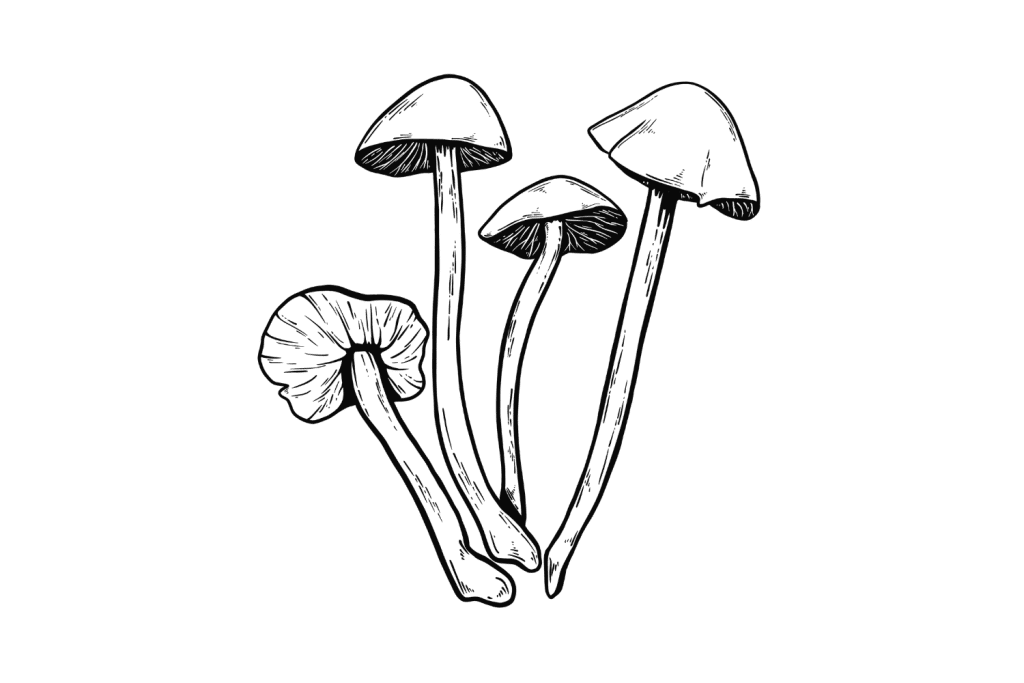
Psilocybe argentipes Specs:
| Potency | Mildly Active |
| Avg. Psilocybin Content | Unknown |
| Avg. Psilocin Content | Unknown |
| Avg. Baeocystin Content | Unknown |
| Distribution | Japan |
| Cultivation Difficulty | Difficult |
Psilocybe aucklandii
As the name implies, this species is found almost exclusively in New Zealand, specifically around the city of Auckland.
Psilocybe aucklandii prefers soils rich in decaying wood debris and leaf litter. It’s more common in areas with Leptospermum (tea trees) and Dacrydium pine trees.
The specific psilocybin and psilocin content remains unknown, but people taking these mushrooms report them as moderately potent — comparable to Psilocybe cubensis.
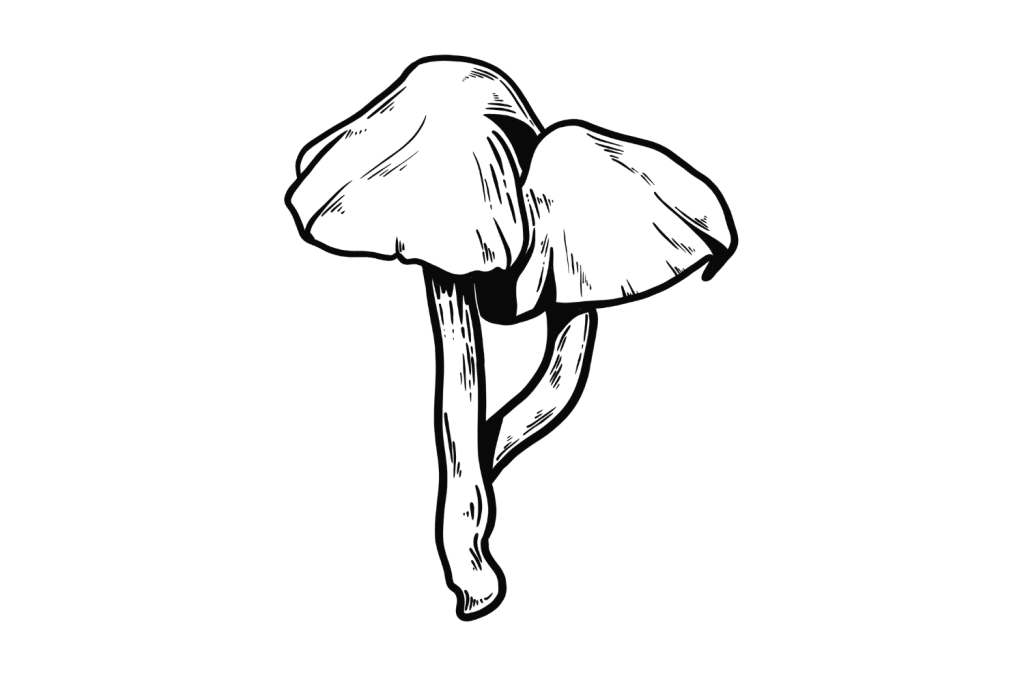
Psilocybe aucklandii Specs:
| Potency | Mildly to Moderately Active |
| Avg. Psilocybin Content | Unknown |
| Avg. Psilocin Content | Unknown |
| Avg. Baeocystin Content | Unknown |
| Distribution | New Zealand |
| Cultivation Difficulty | Difficult |
Psilocybe australiana
This psilocybin mushroom species is most common in Australia — especially in gardens in coastal regions of the continent.
Psilocybe australiana prefers the wood from Pinus radiata trees, which is often used as a mulch for gardens and alongside park trails. You can sometimes find these mushrooms poking up through the mulch after a few days of rain.
The psilocybin and psilocin content is unknown, but the psychoactive effects of these mushrooms are considered weak to moderately potent.
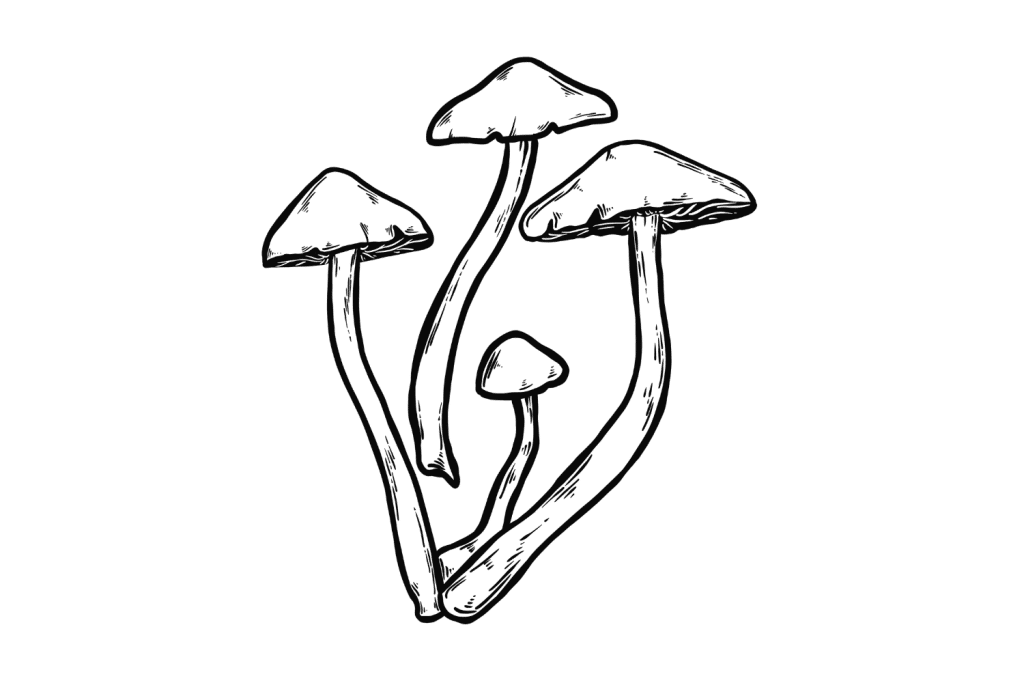
Psilocybe australiana Specs:
| Potency | Weak to moderately Active |
| Avg. Psilocybin Content | Unknown |
| Avg. Psilocin Content | Unknown |
| Avg. Baeocystin Content | Unknown |
| Distribution | Coastal Australia |
| Cultivation Difficulty | Difficult |
Psilocybe aztecorum
The Nahuatl people of Mexico and Central America used this magic mushroom species for ceremonial purposes. They referred to these shrooms as apipltzin— which loosely translates to “little children.”
You can find these mushrooms throughout the high mountains of Mexico, with some samples being reported as high as 4000m in elevation — the highest ever reported for Psilocybe mushrooms.
These shrooms prefer pine forests where they’re sometimes seen protruding out of fallen pine cones.
The psilocybin mushroom species and psilocin content is still unknown for this species. Albert Hofmann reported the actives at concentrations of just 0.02% — but the samples he was using were nearly 2-years old. Most likely, the psilocybin content is much higher as these mushrooms are considered moderately to highly active.
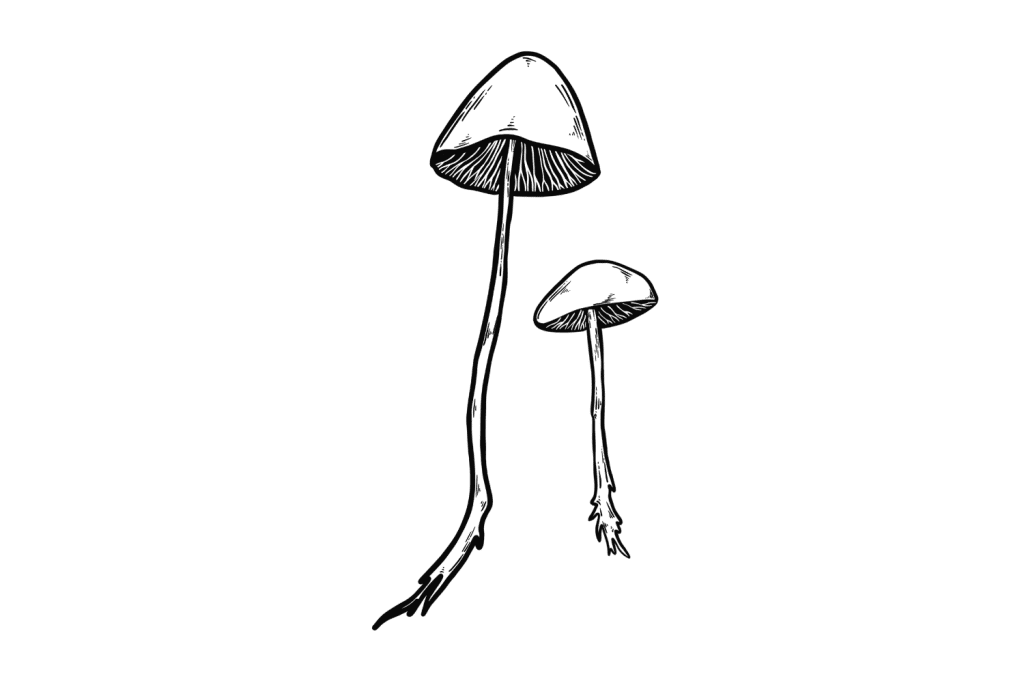
Psilocybe aztecorum Specs:
| Potency | Moderately Active |
| Avg. Psilocybin Content | Unknown |
| Avg. Psilocin Content | Unknown |
| Avg. Baeocystin Content | Unknown |
| Distribution | Mexico |
| Cultivation Difficulty | Difficult |
Psilocybe azurescens
The common names for these mushrooms are “flying saucer mushrooms,” “blue runners,” or “azzies.”
Psilocybe azurescens is hands down the strongest species of Psilocybemushrooms currently known. They’re nearly three times as potent as psilocybe cubensis — producing powerful psychoactive effects at doses as low as 1 gram of dried shrooms.
This species can be found on the West Coast of North America. They’re common in California, Oregon, and Washington, and some people have even found them growing as far north as British Columbia.
P. azurescens can withstand colder winters than most psilocybin mushroom species but struggle in regions that dip below freezing for more than a couple of days at a time.
Despite how strong these mushrooms are, they’re rarely available from mushroom vendors or spore suppliers because of how hard they are to cultivate indoors. Some people have found success growing these mushrooms outdoors, but you’re limited to specific regions with climates these mushrooms can endure.
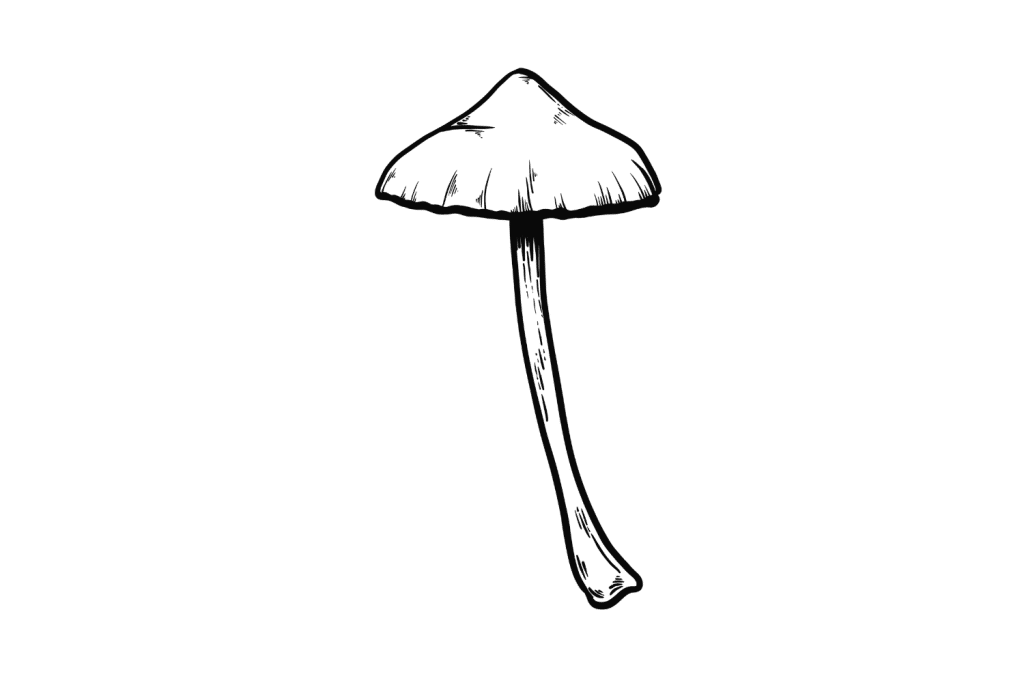
Psilocybe azurescens Specs:
| Potency | Extremely Potent |
| Avg. Psilocybin Content | 1.78% |
| Avg. Psilocin Content | 0.38% |
| Avg. Baeocystin Content | 0.35% |
| Distribution | West coast of North America |
| Cultivation Difficulty | Moderate |
Psilocybe baeocystis
Psilocybe baeocystis can be found in wooded areas, especially in regions with lots of Douglas fir trees.
This is the psilocybin mushroom species in which the alkaloid known as baeocystin was first discovered. However, the story behind its discovery is a bit tragic.
A group of individuals who took wildcrafted mushrooms thought to be Psilocybe baeocystis experienced severe mushroom poisoning. A child in the group even died from the incident, and several others were hospitalized.
Researchers investigated the mushrooms in search of a toxic ingredient that could be held responsible for the poisoning and found baeocystin. This compound is only toxic in very high doses, and several studies have confirmed it’s safe in the dosages listed in magic mushrooms.
Expert mycologists believe the poisoning wasn’t the result of the Psilocybe mushrooms but rather a common look-alike such as a species of Galerina or Amanita.
The common name for this species is “Knobby Tops” because of the dark, wavy, gelatinous caps.
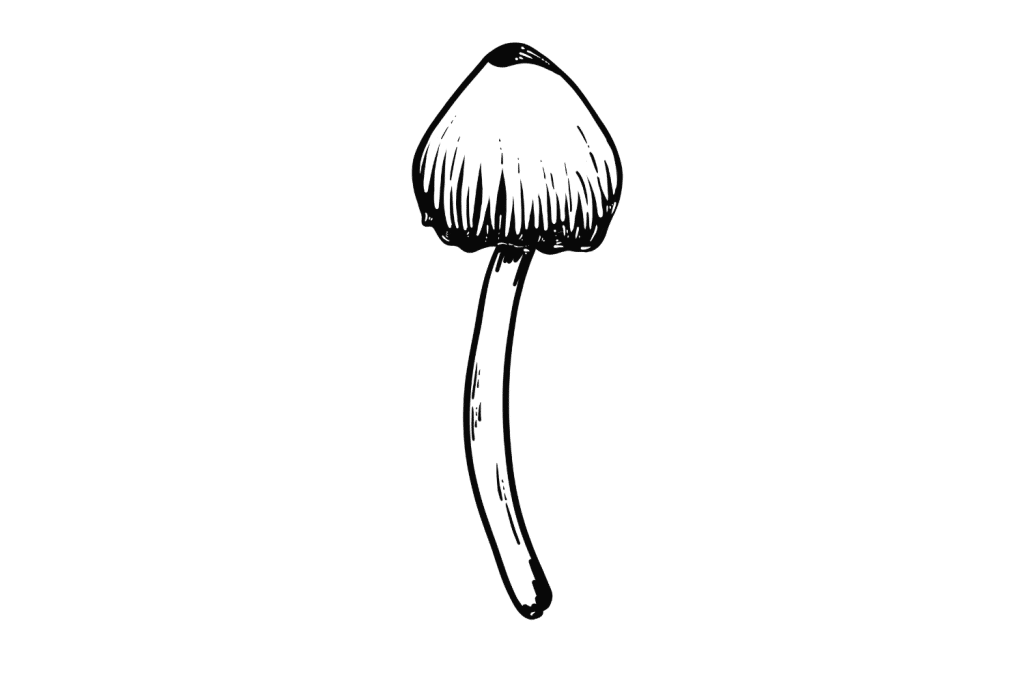
Psilocybe baeocystis Specs:
| Potency | Highly Active |
| Avg. Psilocybin Content | 0.85% |
| Avg. Psilocin Content | 0.59% |
| Avg. Baeocystin Content | 0.10% |
| Distribution | Temperate Forests in North America & Europe |
| Cultivation Difficulty | Moderate |
Psilocybe bohemica
The common name for this species is “The Bohemian Psilocybe.”
This mushroom can be found in deciduous forests that contain lots of birch and hornbeam trees throughout central Europe.
The shrooms have lightly colored caps and white stems and produce a greyish-purple spore print.
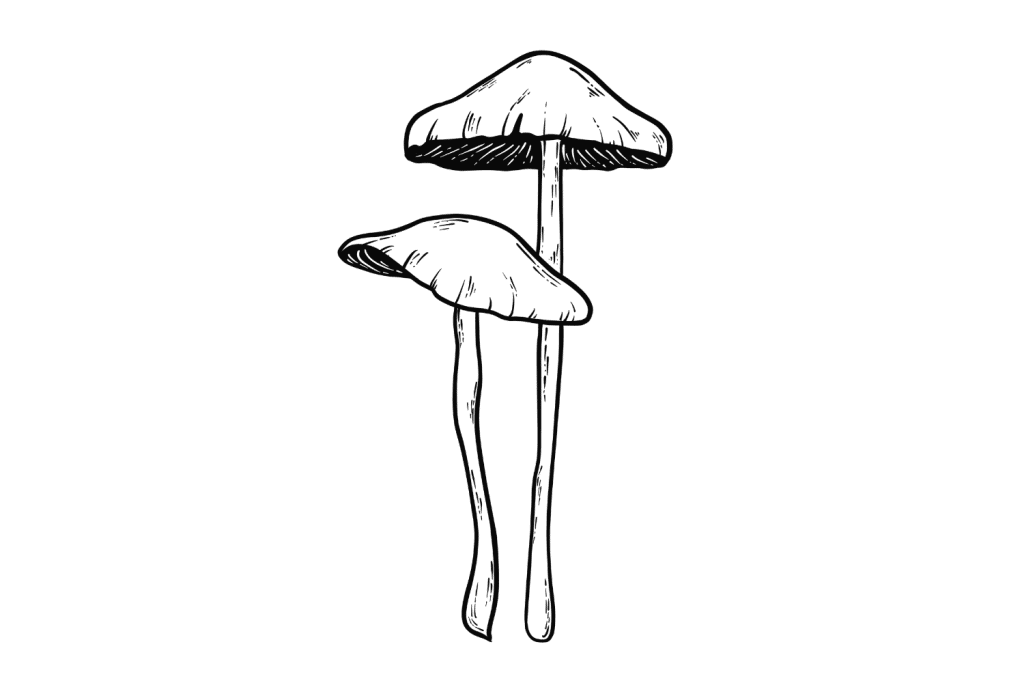
Psilocybe bohemica Specs:
| Potency | Highly Active |
| Avg. Psilocybin Content | 1.34% |
| Avg. Psilocin Content | 0.11% |
| Avg. Baeocystin Content | 0.02% |
| Distribution | Central Europe |
| Cultivation Difficulty | Moderate |
Psilocybe braziliensis
There isn’t much information on this species — and we still don’t know the average psilocybin or psilocin content of these mushrooms.
However, mycologists believe this species has particularly high psychoactivity based on the intensity of the bluing reaction when touched. This reaction only happens in mushrooms that contain psilocybin mushroom species or psilocin.
Psilocybe braziliensis can be found in tropical environments such as Brazil or other central and South American forests.
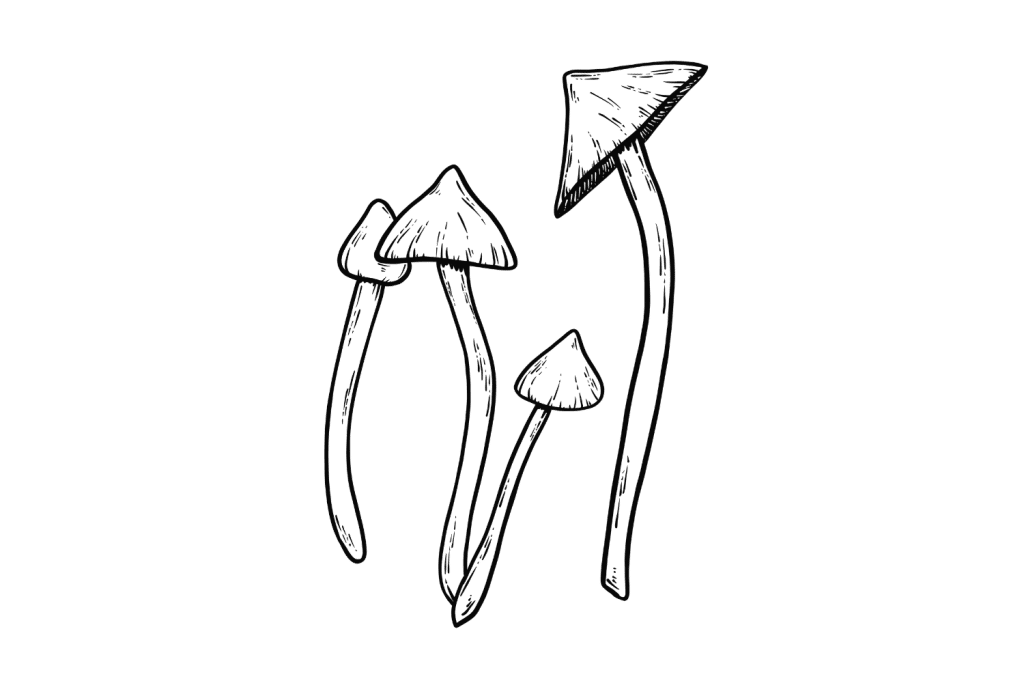
Psilocybe braziliensis Specs:
| Potency | Moderately to Highly Active |
| Avg. Psilocybin Content | Unknown |
| Avg. Psilocin Content | Unknown |
| Avg. Baeocystin Content | Unknown |
| Distribution | Central & Tropical South America |
| Cultivation Difficulty | Moderate |
Psilocybe caerulescens
This psilocybin mushroom species has two common names — “Derrumbes” or “Landslide Mushrooms”. The name comes from the fact that these mushrooms tend to pop up after a landslide after much of the existing foliage has been wiped out. It’s likely the mushrooms take the influx of dead and decaying plant material after a landslide to spread its spores in search of more abundant food sources.
This species was first reported from a sample taken in Montgomery, Alabama, in 1923. It wasn’t until R. Gordon Wasson was given a sample of these mushrooms on his infamous trip to Mexico in the 1950s that it really became popular.
Psilocybe caerulescens is a popular species used by shamans in Mexico around the Sierra Madre mountain range, where they grow most abundantly.
The psilocybin and psilocin content of this species is markedly low, but these mushrooms are much more powerful than they’re given credit for.
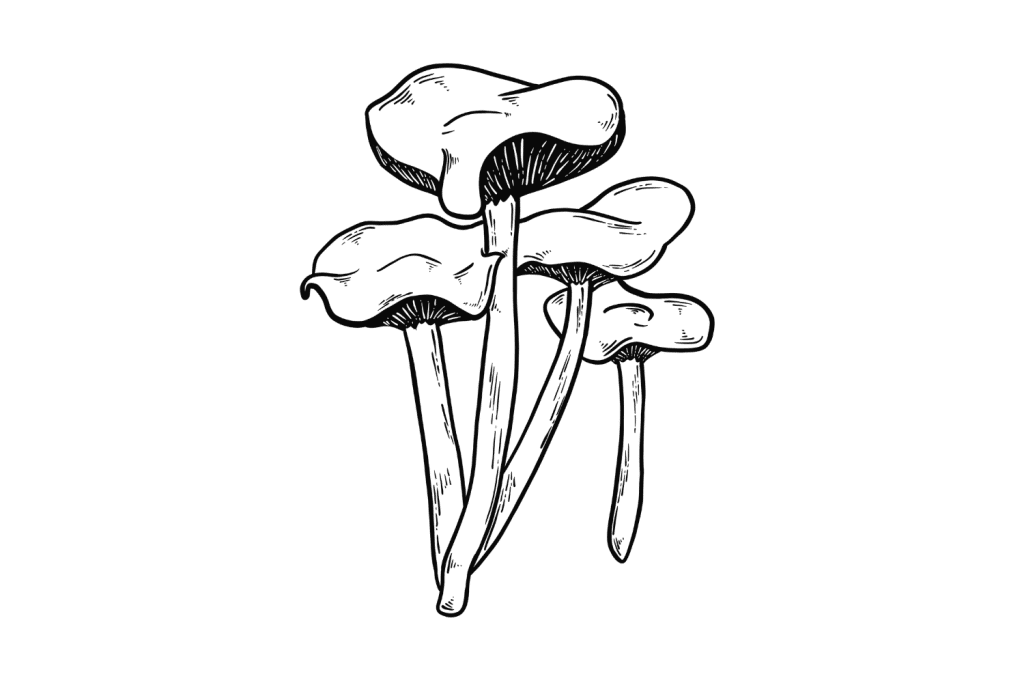
Psilocybe caerulescens Specs:
| Potency | Weakly Active |
| Avg. Psilocybin Content | 0.20% |
| Avg. Psilocin Content | 0% |
| Avg. Baeocystin Content | Unknown |
| Distribution | Sierra Madre Mountain Range in Mexico |
| Cultivation Difficulty | Difficult |
Psilocybe caerulipes
The common name for this mushroom is the “Blue Foot Mushroom” because of the blue base of the stem.
This psilocybin mushroom species is hard to find, but once you’ve found them, keep coming back for more as these shrooms will continue to pop up in the same location year after year.
The most common place to find these mushrooms is around rivers in hardwood forests in the midwest US and Canada. There are reports of this species popping up in parts of Europe as well — but it’s much less common.
The psilocybin and psilocin content of this species remains unknown, but the potency is reported to be comparable to Psilocybe cubensis.
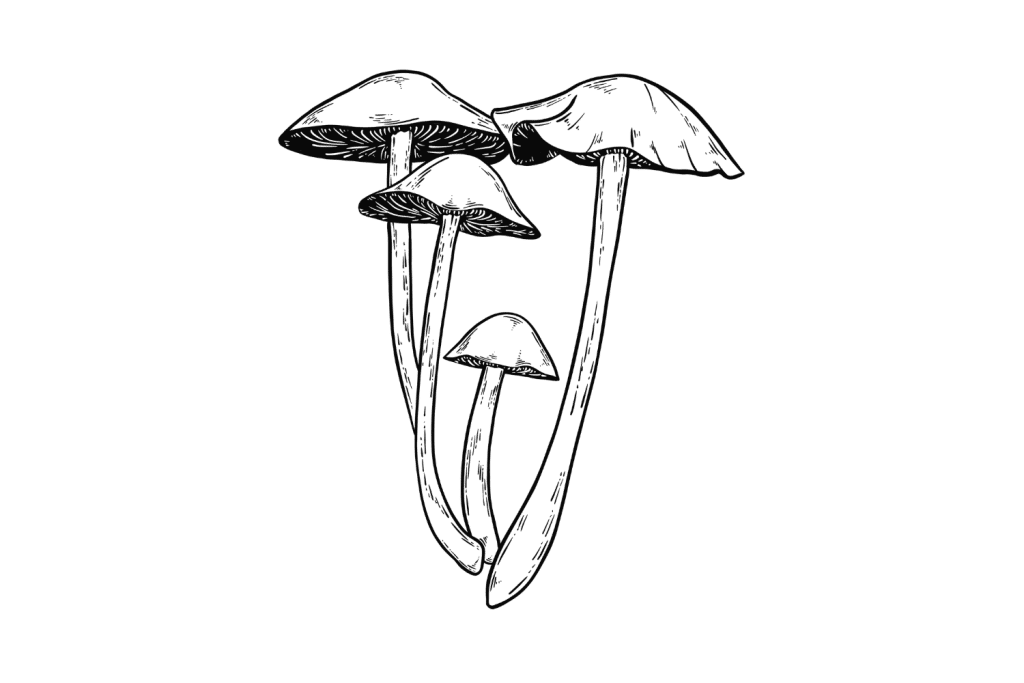
Psilocybe caerulipes Specs:
| Potency | Activity Unknown |
| Avg. Psilocybin Content | Unknown |
| Avg. Psilocin Content | Unknown |
| Avg. Baeocystin Content | Unknown |
| Distribution | Midwestern US & Canada |
| Cultivation Difficulty | Moderate |
Psilocybe cubensis
If you’ve ever tried magic mushrooms, there’s a very high chance the species you used was Psilocybe cubensis.
This species is extremely common — found naturally on all continents short of Antarctica. They’re also the easiest species to cultivate, produce high yields, and are notably potent.
This species was first reported by R. Gordon Wasson. He published a piece in Life magazine in 1957 in which he described his experience taking ceremonial psychoactive mushrooms with a shaman on a trip to Mexico. This marked the first time a Westerner had been allowed to take part in the ceremony.
Wasson’s entry in Life magazine was reportedly a catalyst for other famous psychonauts‘ entry into the world of psychedelics, including Alan Watts, Terence McKenna, and Alexander Shulgin.
After the trip, Wasson sent a sample of these mushrooms (along with Psilocybe mexicana) to Albert Hofmann — the man who discovered LSD. It was Hofmann that discovered and documented the structure of psilocybin, psilocin, and two other minor psychedelic compounds from these samples.
Psilocybe cubensis aren’t the most potent species of magic mushrooms, not by a longshot. In fact, Paul Stamets‘ report in his book Psilocybin Mushrooms of the World lists them at number seven in terms of potency within the Psilocybe genus.
With that said, P. cubensis are strong enough to reliably induce powerful psychedelic experiences with as little as two grams of dried fruiting bodies.
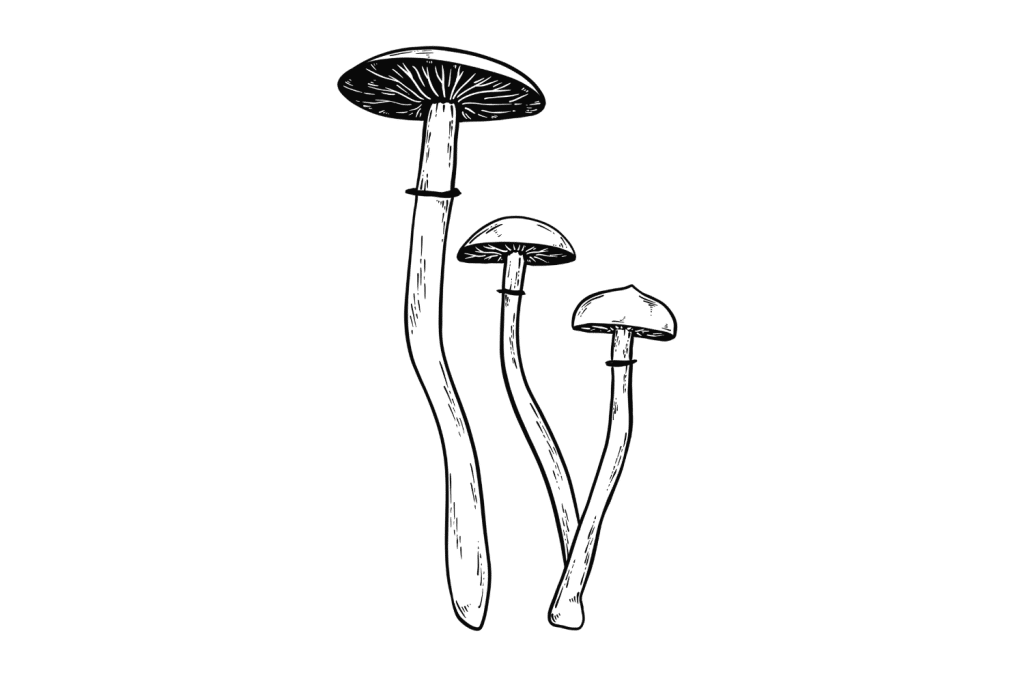
Psilocybe cubensis Specs:
| Potency | Highly Active |
| Avg. Psilocybin Content | 0.63% |
| Avg. Psilocin Content | 0.60% |
| Avg. Baeocystin Content | 0.25% |
| Distribution | Warmer regions of North and South America, Africa, the Mediterranean, Southeast Asia, and Australia |
| Cultivation Difficulty | Easy |
Psilocybe cyanofibrillosa
Psilocybe cyanofibrillosa can be found growing around coastal extending from Northern California up to British Colombia, Canada.
This species like growing in regions with lots of lupines near floodplains and river estuaries.
The psilocybin mushroom species content isn’t well known, but the concentration of active ingredients is much higher in fresh samples than dried samples. They’re considered moderately potent when fresh and weakly active when dried.
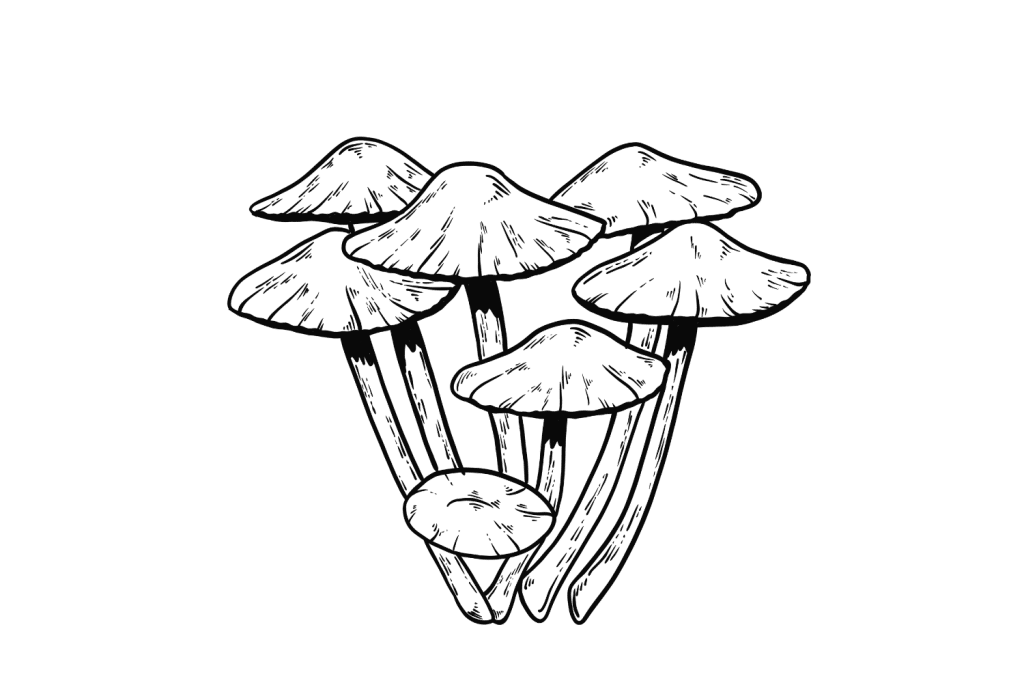
Psilocybe cyanofibrillosa Specs:
| Potency | Moderately Active |
| Avg. Psilocybin Content | 0.21% |
| Avg. Psilocin Content | 0.06% |
| Avg. Baeocystin Content | Unknown |
| Distribution | West Coast of North America |
| Cultivation Difficulty | Intermediate |
Psilocybe cyanescens
The common name for this species is “wavy caps” because of the characteristic wavy appearance of these mushrooms. This is one of the key distinguishing features that make this mushroom much easier to identify than other species of Psilocybe mushrooms.
Elsie Wakefield first identified wavy caps in 1946, but she was reportedly harvesting these mushrooms long before that.
Psilocybe cyanesecens is one of the most widespread members of the genus. Some experts believe they originated in Europe or possibly somewhere in the Pacific Northwest of the United States. However, today these mushrooms can be found on just about every continent on Earth.
You’ll find these mushrooms in areas with lots of decaying wood, including the sides of trails, or in gardens using wood chips as mulch. This wood-loving fungus is thought to have spread so far and wide by traveling on lumber.
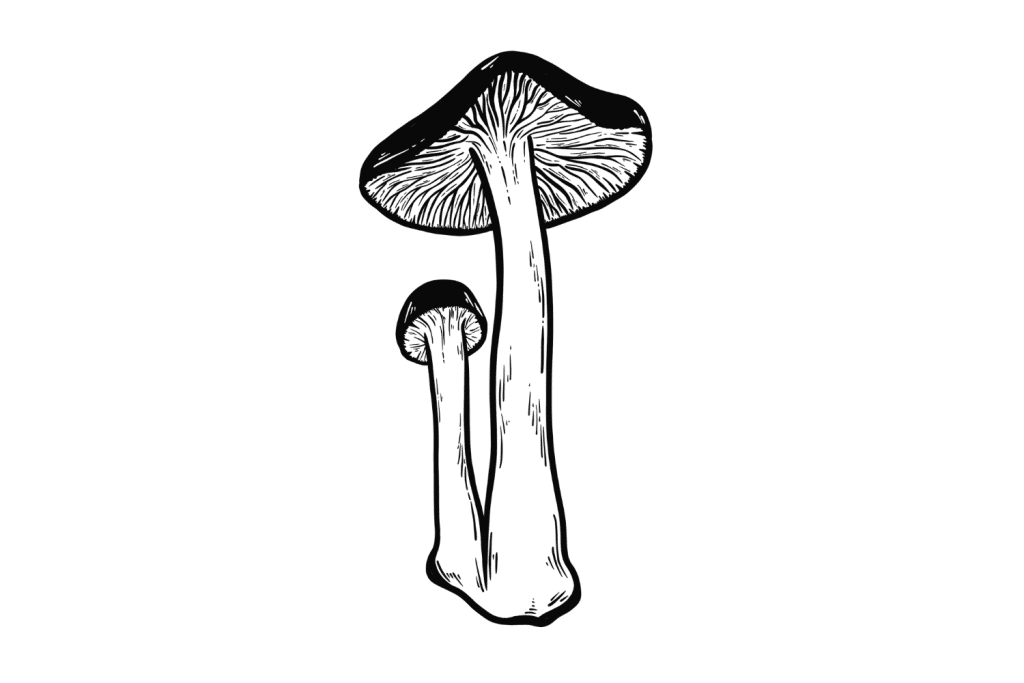
Psilocybe cyanescens Specs:
| Potency | Highly Active |
| Avg. Psilocybin Content | 0.85% |
| Avg. Psilocin Content | 0.36% |
| Avg. Baeocystin Content | 0.03% |
| Distribution | Worldwide in places with lots of decaying wood |
| Cultivation Difficulty | Difficult |
Psilocybe mexicana
This psilocybin mushroom species is commonly referred to as “Pajaritos” (little birds) in Mexico. They’re small but highly potent magic mushrooms.
A unique feature of these mushrooms is their ability to produce both magic mushrooms and magic truffles (sclerotia).
Experts believe this was the predominant species used by the Aztec people, where it was referred to as “Teonanacatl” — meaning “flesh of the gods.”
You can find this mushroom growing in wet regions of Southern US and Mexico at elevations ranging from sea level to 1800 m. They prefer areas with lots of dung or other decaying matter. Unlike other dung-loving mushrooms, Psilocybe mexicana rarely grows directly in the dung but will remain nearby.
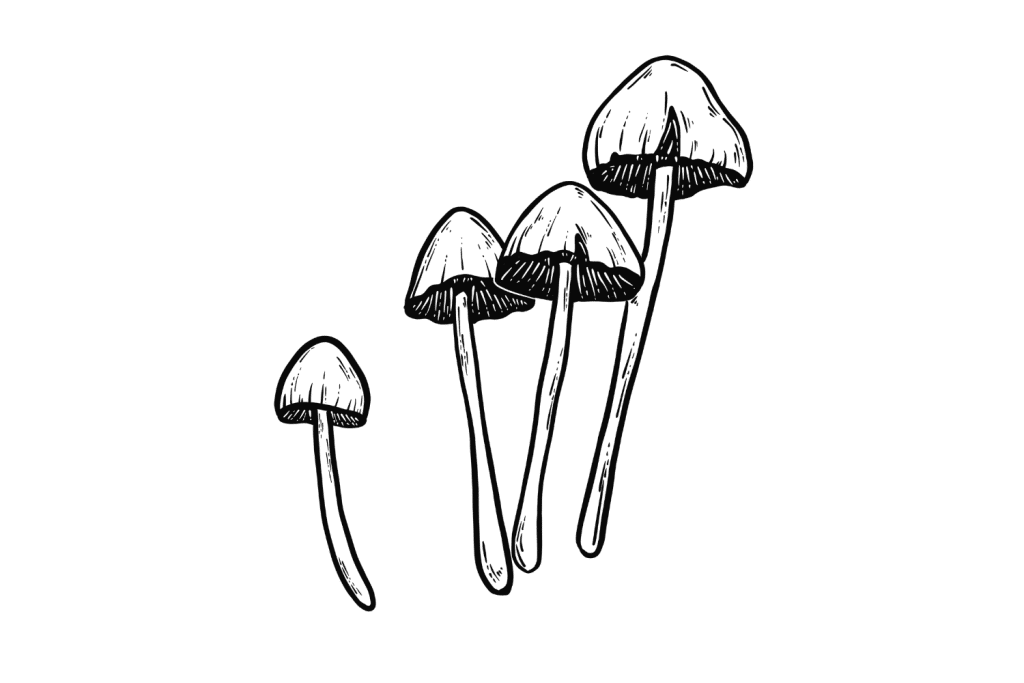
Psilocybe mexicana Specs:
| Potency | Moderately Active |
| Avg. Psilocybin Content | 0.25% |
| Avg. Psilocin Content | 0.15% |
| Avg. Baeocystin Content | Unknown |
| Distribution | Southern US & Mexico |
| Cultivation Difficulty | Moderate |
Psilocybe hoogshagenii
The common name for this species is “The Little birds of the woods.”
Unfortunately, not much is known about this species, and it’s not commonly used outside of specific regions in Brazil, Mexico, Colombia, and Argentina. This species is often found in and around coffee plantations.
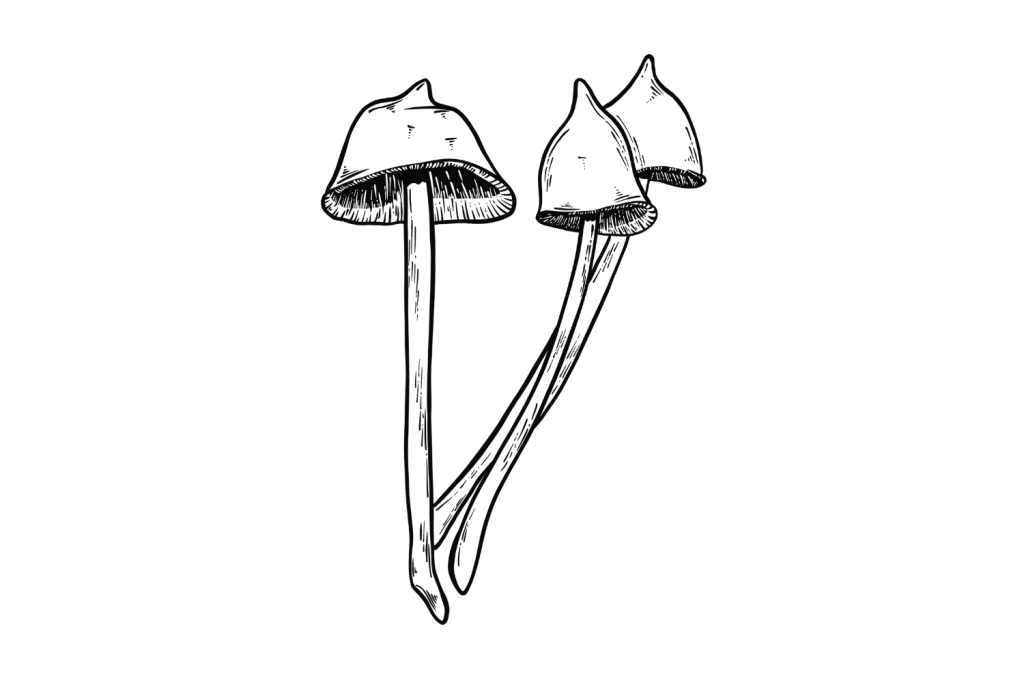
Psilocybe hoogshagenii Specs:
| Potency | Moderately Active |
| Avg. Psilocybin Content | 0.30% |
| Avg. Psilocin Content | 0.30% |
| Avg. Baeocystin Content | Unknown |
| Distribution | Central & South America |
| Cultivation Difficulty | Difficult |
Psilocybe samuiensis
This rare species of Psilocybe was first discovered in Koh Samui by Mushroom John Allen. It’s unclear how widespread this mushroom is, but it’s proven to be very difficult to find among mushroom hunters. It’s likely the fruiting season for this species is very short.
The appearance of this mushroom is very similar to Psilocybe semilanceata(Liberty Caps), with small, slender stems and a bell-shaped cap.
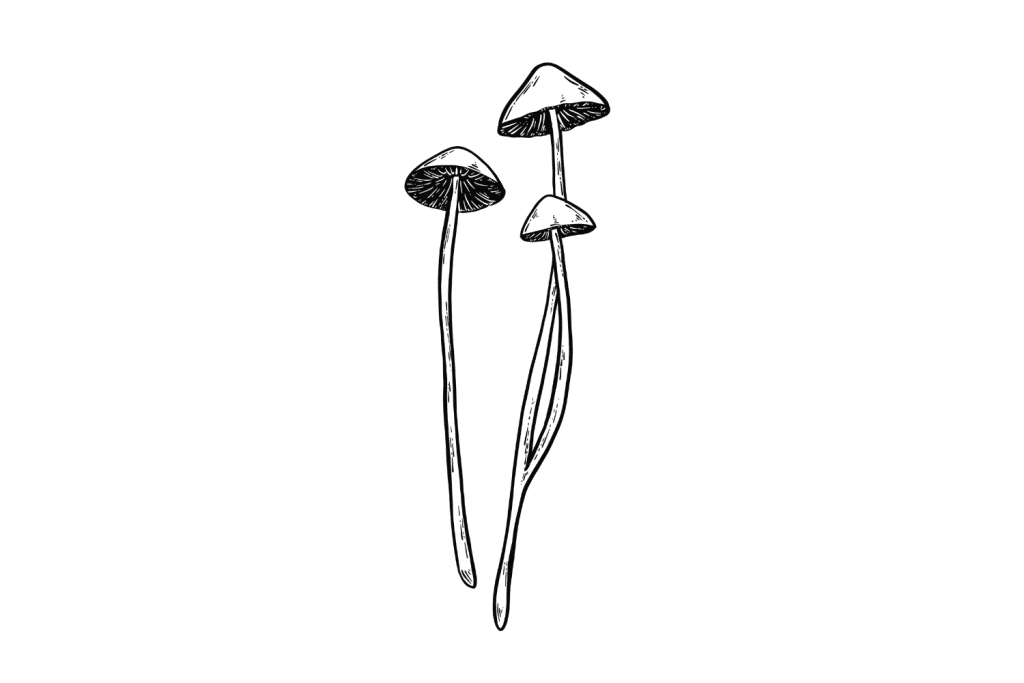
Psilocybe samuiensis Specs:
| Potency | Moderately to Highly Active |
| Avg. Psilocybin Content | 0.73% |
| Avg. Psilocin Content | 0.52% |
| Avg. Baeocystin Content | 0.05% |
| Distribution | Thailand |
| Cultivation Difficulty | Easy |
Psilocybe semilanceata
The common name for this species is “liberty caps” because of the distinct bell-shaped caps.
Psilocybe semilanceata is very common in the wild but notoriously difficult to cultivate both indoors and outdoors. It’s also listed by Paul Stamets as the third most potent species of Psilocybe mushrooms.
The small caps and thin stems on these mushrooms make them difficult to spot — especially in grasslands or wooded areas where they like to grow.
The first identification of this mushroom was in 1838 in England and temperate regions of North America. Outside of these regions, P. semilanceata is harder to find, but samples have been reported in Australia, Chile, Argentina, Africa, and Northern India.
There are a lot of poisonous look-alikes for this species to be cautious when wildcrafting.
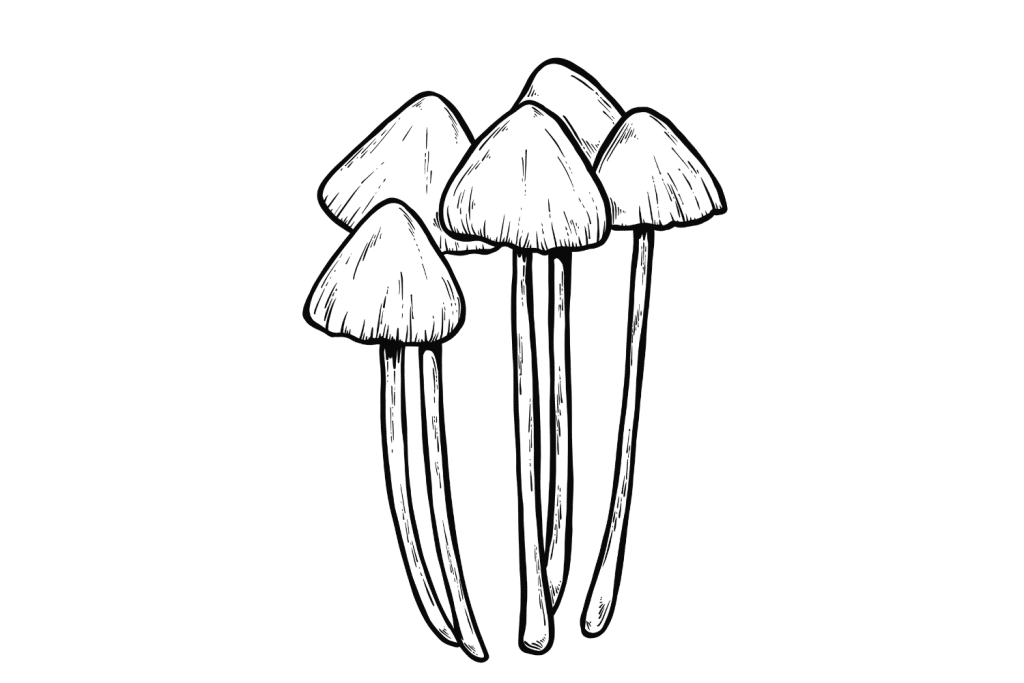
Psilocybe semilanceata Specs:
| Potency | Highly Active |
| Avg. Psilocybin Content | 0.98% |
| Avg. Psilocin Content | 0.72% |
| Avg. Baeocystin Content | 0.36% |
| Distribution | Europe, Australia, Chile, Argentina, Africa, Northern India |
| Cultivation Difficulty | Difficult |
Psilocybe stuntzii
The common name for this psilocybin mushroom species is “blue ringers.” They have a strong blueing reaction when touched, which is a reliable indicator for the presence of psilocybin.
This species was first discovered by Dr. Daniel Stuntz on the University of Washington campus.
You can find these mushrooms along the West Coast of the US and Canada. It’s one of the more common species of magic mushrooms in British Colombia. They can be found in many parks around Vancouver as well as gardens that use wood chips as mulch.
This species prefers decaying wood but will also grow in areas with lots of dead leaves or grass.
Be careful when wildcrafting this species; it sometimes resembles the toxic mushroom species, Galerina marginata.
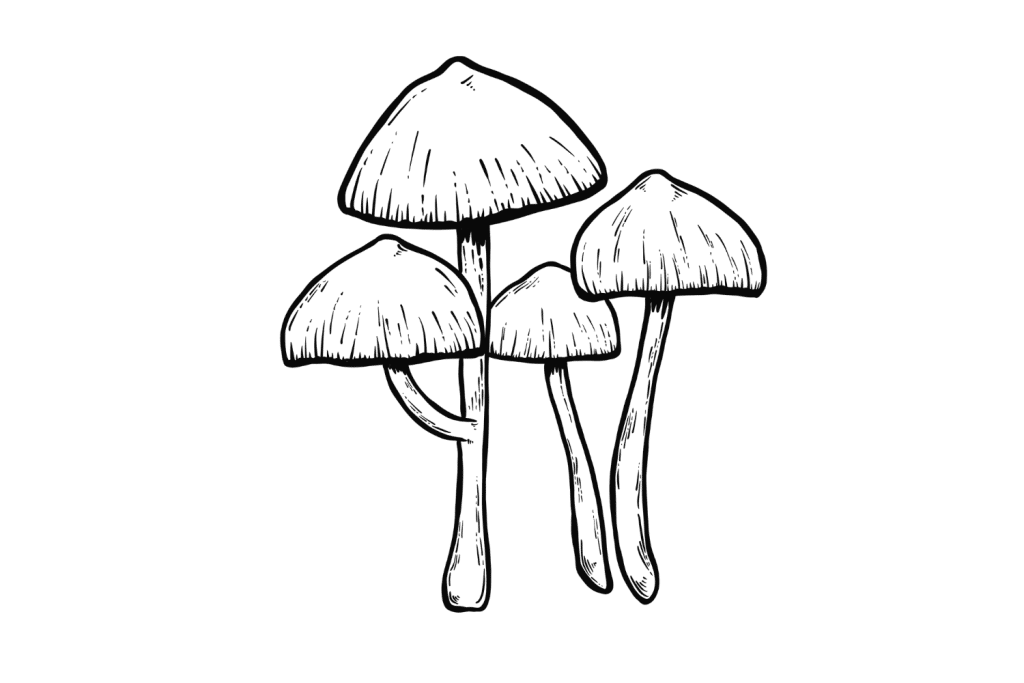
Psilocybe stuntzii Specs:
| Potency | Moderately Active |
| Avg. Psilocybin Content | 0.36% |
| Avg. Psilocin Content | 0.12% |
| Avg. Baeocystin Content | 0.02% |
| Distribution | West Coast of North America |
| Cultivation Difficulty | Difficult |
Psilocybe tampanensis
Most magic truffles are Psilocybe tampanensis — however, it’s also possible to harvest magic truffles from Psilocybe mexicana.
In the Netherlands, the fruiting bodies of magic mushroom species are illegal, but the non-reproductive parts aren’t. This has led to the widespread cultivation of P. tampanensis because of its ability to form psilocybin-rich sclerotia — which are masses of mycelia that form underground.
Sometimes referred to as “Philosopher’s stones” or “magic truffles”, you can find this species at most mushroom dispensaries and coffee shops in places like Amsterdam.
This species is very easy to cultivate at home but requires some tweaks compared to conventional magic mushroom cultivation to maximize sclerotia or truffle formation.
It’s rare to find this species in the wild, but there are reports of people collecting samples in Florida and other parts of the tropical US.
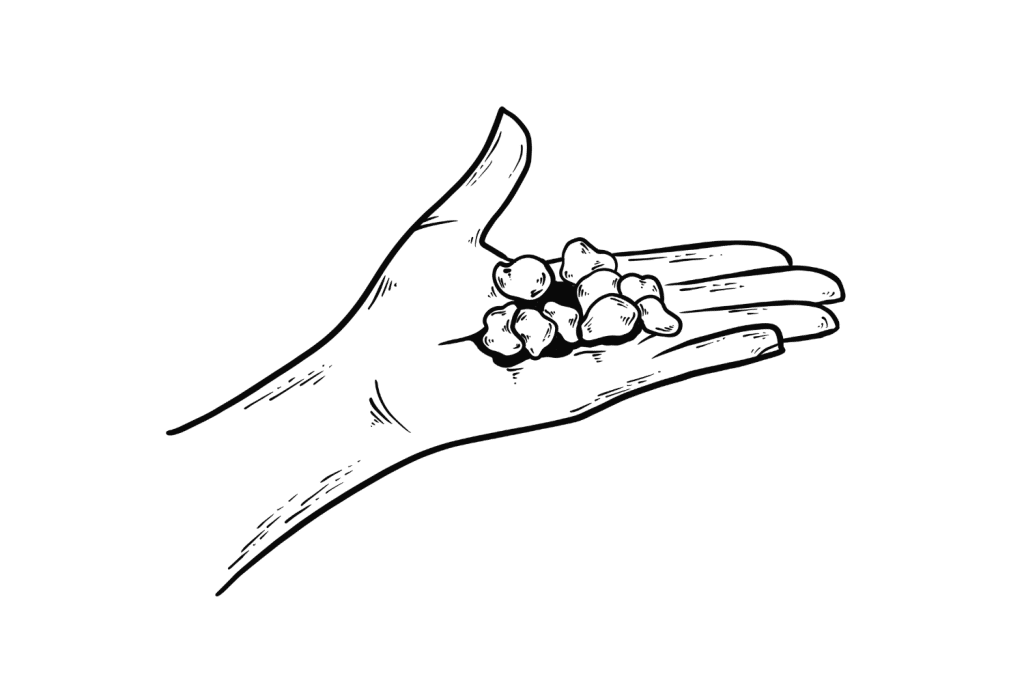
Psilocybe tampanensis Specs:
| Potency | Highly Active |
| Avg. Psilocybin Content | 0.68% |
| Avg. Psilocin Content | 0.32% |
| Avg. Baeocystin Content | Unknown |
| Distribution | Tropical US |
| Cultivation Difficulty | Easy |
Psilocybe zapotecorum
This psilocybin mushroom species is named after the Zapotec indigenous community of Oaxaca, Mexico. It’s thought that this species was the most common magic mushroom used by these cultures in the past.
In the Zapotec language, these mushrooms were referred to as Bado or Bado Zoo — which loosely translates to “drunk god.”
This species can be found growing outside of Mexico in places like Brazil and Colombia.
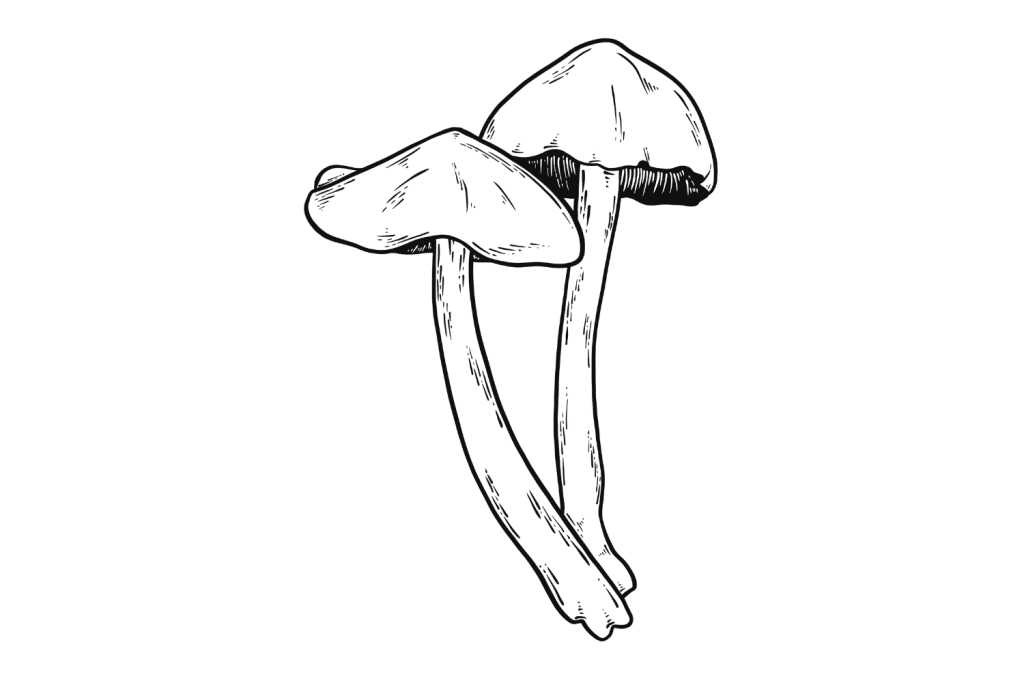
Psilocybe zapotecorum Specs:
| Potency | Highly Active |
| Avg. Psilocybin Content | 0.30% |
| Avg. Psilocin Content | 1.00% |
| Avg. Baeocystin Content | Unknown |
| Distribution | Mexico, Brazil, Colombia |
| Cultivation Difficulty | Difficult |
Psilocybe weilii
Psilocybe weilii is named after Dr. Andrew Weil, a famous doctor who’s been instrumental in helping to bring public awareness about the medicinal applications of mushrooms.
This species is common in areas with lots of red clay in the soil. It grows in coniferous forests in North America and some parts of Europe.
Aside from the psilocybin and psilocin content (which are comparable to Psilocybe cubensis), this species has a high concentration of tryptophan (around 0.32%).
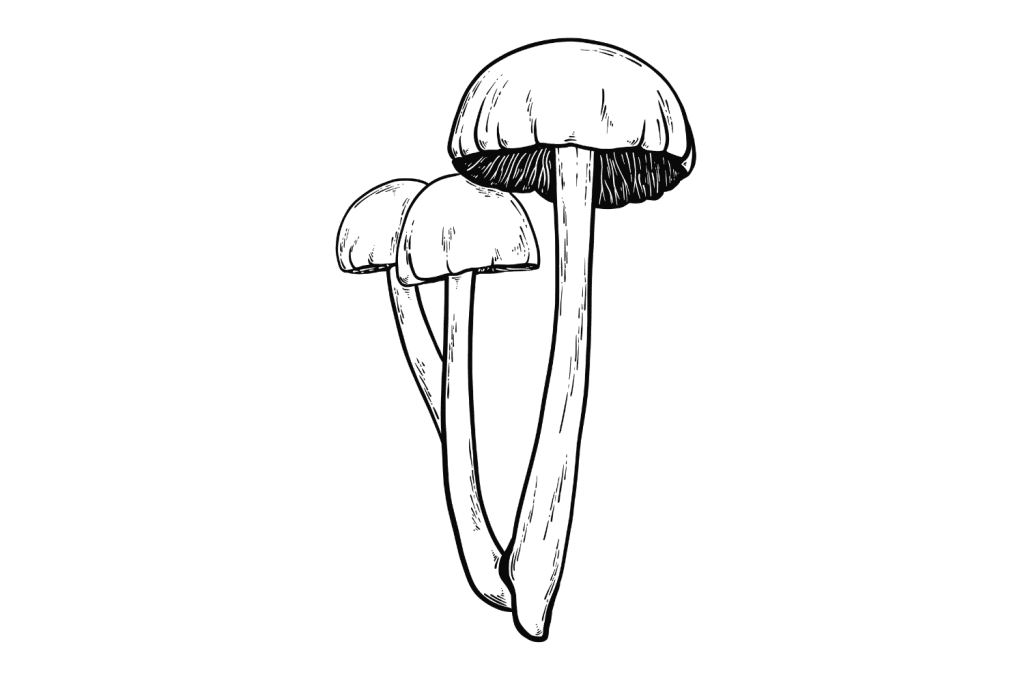
Psilocybe weilii Specs:
| Potency | Highly Active |
| Avg. Psilocybin Content | 0.61% |
| Avg. Psilocin Content | 0.27% |
| Avg. Baeocystin Content | 0.05% |
| Distribution | North America, Central Europe |
| Cultivation Difficulty | Moderate |
2. Panaeolus
The Panaeolus genus is a member of the larger Coprinaceae family. Panaeolusisn’t the only psilocybin-containing member of this family, but it’s definitely the most notable — both in terms of the potency of psilocybin-containing species and the sheer number of psychoactive members.
Other members of the Coprinaceae family that contain psilocybin include Psathyrella and Coprinus.
There are currently 13 known species of Panaeolus that contain psilocybin and psilocin — most are considered weakly active, but a small handful is considered highly active.
Most Panaeolus’ prefer the same growing conditions as Psilocybe — which includes pastures with lots of manure, grasslands, and wooded fields with lots of old decaying trees.
Panaeolus cambodginiensis
This species is characterized by its golden cap and deep black-colored spores. It’s primarily found in Cambodia and other parts of tropical Asia, as well as Hawaii and several other islands in the South Pacific.
This species is considered on-par with Psilocybe cubensis in terms of its psychoactive effects.
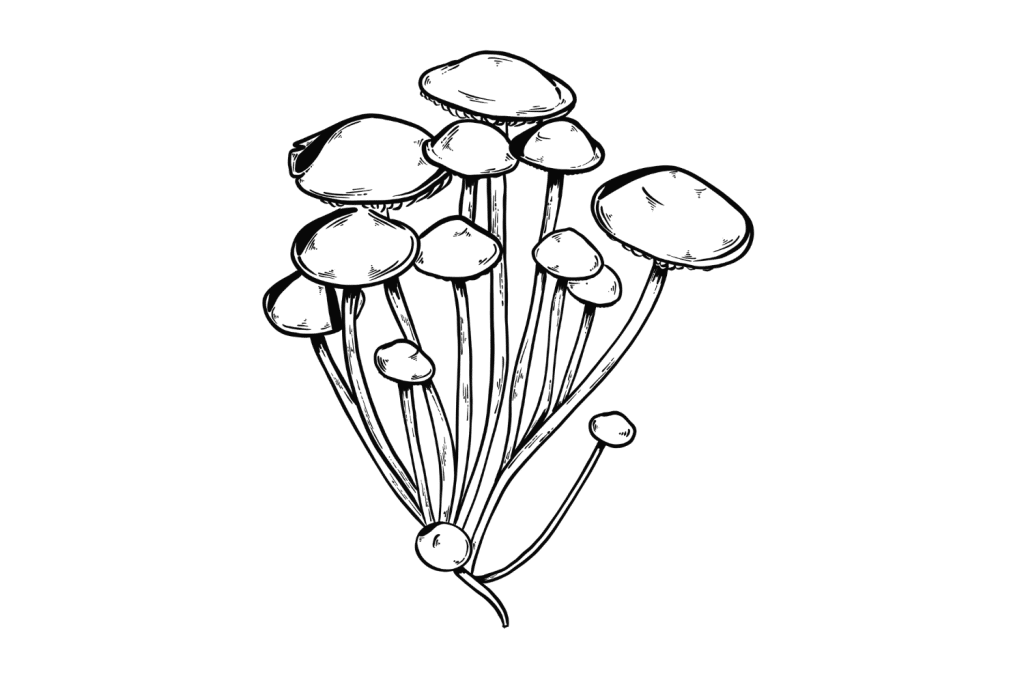
Panaeolus cambodginiensis Specs:
| Potency | Highly Active |
| Avg. Psilocybin Content | 0.55% |
| Avg. Psilocin Content | 0.6% |
| Avg. Baeocystin Content | Unknown |
| Distribution | Southeast Asia & Hawaii |
| Cultivation Difficulty | Difficult |
Panaeolus cyanescens
Panaeolus cyanescens is the strongest member of the Panaeolus genus. The common name for these mushrooms is “Blue Meanies.” This name has led to a lot of confusion because there’s also a popular strain of Psilocybe cubensis that goes by the same common name. These mushrooms are distinct from each other.
These mushrooms have a light caramel-colored cap and stem and demonstrate a strong blushing reaction when touched due to the high psilocybin content.
Panaeolus cyansecens is roughly three times more potent than Psilocybe cubensis gram for gram, so be cautious when dosing this species of mushroom.
You can find P. cyanescens in tropical parts of the US, especially around pastures. This is a dung-loving species found most abundantly in places with lots of livestock. There are also reports of this mushroom in Hawaii, Mexico, Brazil, Costa Rica, the Caribbean, Thailand, Brazil, and Australia.
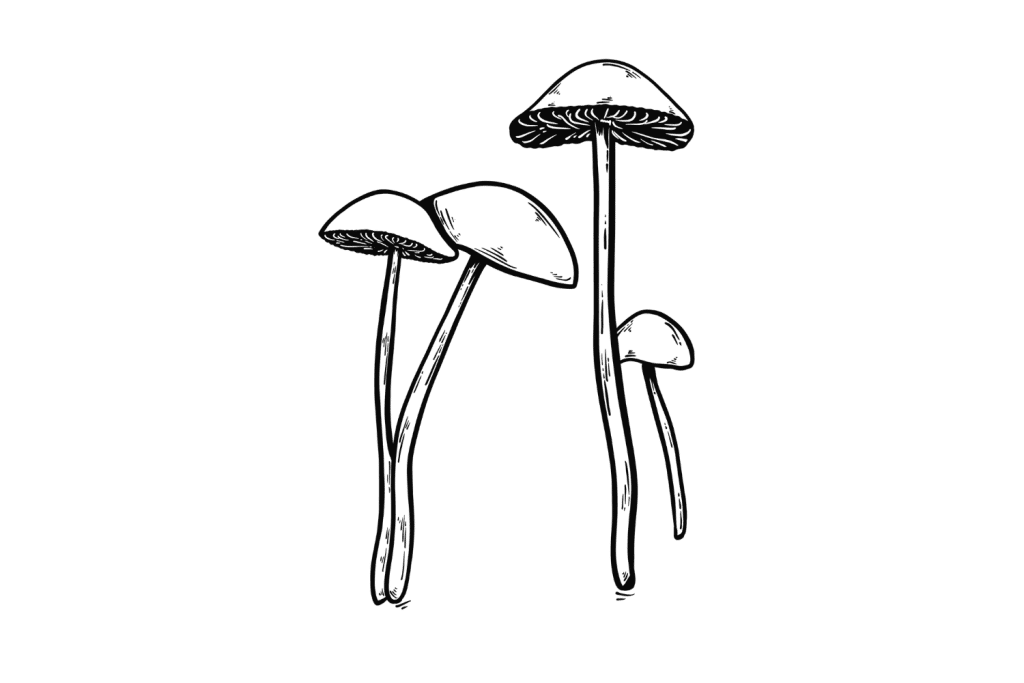
Panaeolus cyanescens Specs:
| Potency | Highly Active |
| Avg. Psilocybin Content | 0.71% |
| Avg. Psilocin Content | 0.04% |
| Avg. Baeocystin Content | 0.01% |
| Distribution | Subtropical regions of the US, Central & South America, and Southeast Asia |
| Cultivation Difficulty | Moderate |
Panaeolus tropicalis
P. tropicalis has a very similar appearance to Panaeolus cyansescens — with greyish to yellow colored caps and a strong bluing reaction when touched. The caps tend to darken with age.
Much like P. cyanescens, this species is most common in tropical and subtropical pastures, where it thrives in areas with plenty of manure.
The psilocybin mushroom species and psilocin content of this species is unknown, but it’s reported to be very strong by people who have tried it.
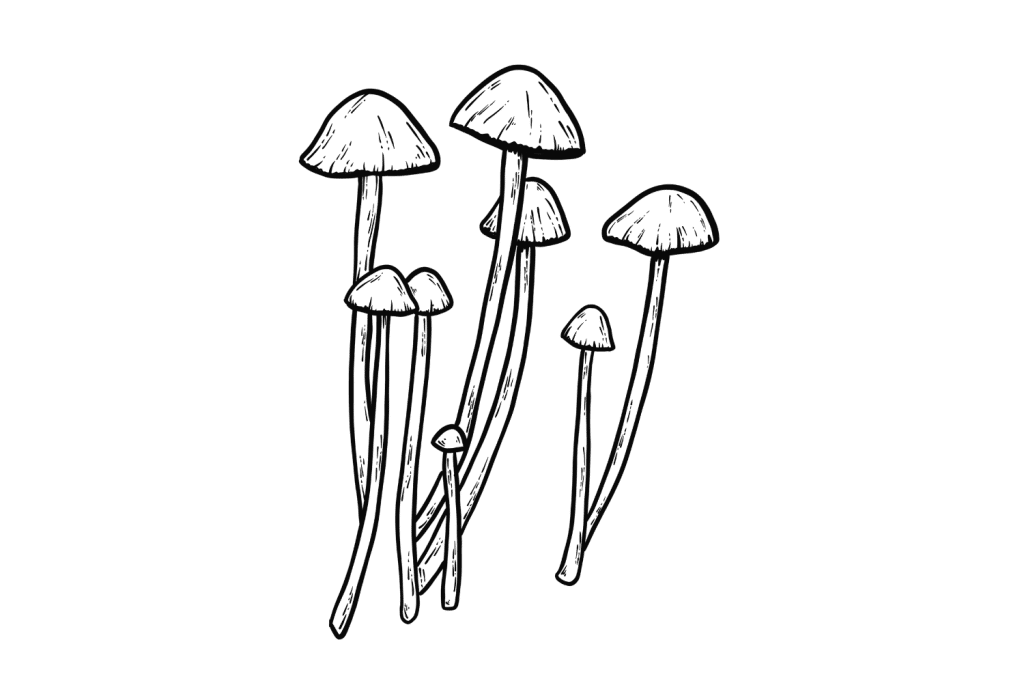
Panaeolus tropicalis Specs:
| Potency | Moderately to Highly Active |
| Avg. Psilocybin Content | Unknown |
| Avg. Psilocin Content | Unknown |
| Avg. Baeocystin Content | Unknown |
| Distribution | Hawaii, Central Africa, Southeast Asia |
| Cultivation Difficulty | Difficult |
3. Conocybe
Conocybe is considered a minor psilocybin-containing genus because there are only a few species that contain psychoactive doses of the active psilocybin or psilocin. The species that are psychoactive are only mildly to moderately psychoactive at best.
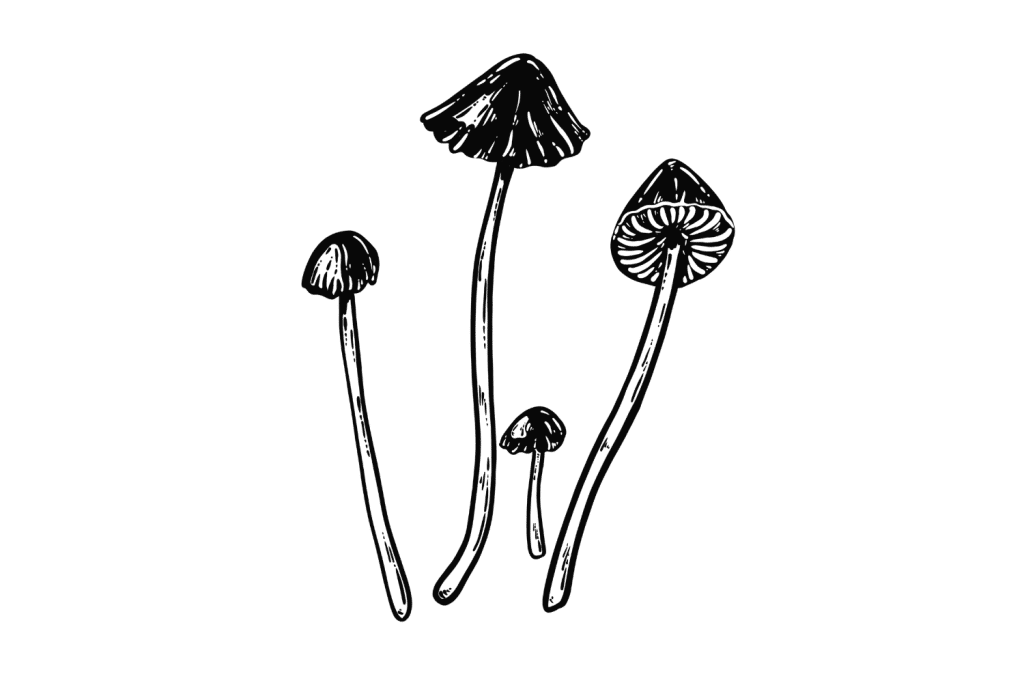
This genus is characterized by long, thin, fragile stems. These mushrooms are very small, often forming dense clusters with more than 100 individual mushrooms in clusters.
Unfortunately, many of the psychoactive members of this genus closely resemble Galerina species — which are toxic.
The most notable psychoactive member of this genus is Conocybe cyanopus — which was reportedly used in Mexico for shamanic purposes by Mazatec groups.
Psychoactive members of the Conocybe genus include:
- Conocybe siligineoides
- Conocybe cyanopus
- Conocybe siligineoides
- Conocybe kuehneriana
4. Gymnopilus
There are around 150 species within the Gymnopilus spread all over the world. The largest concentration of species is in North America, where no less than 75 individual species have been documented.
Ten psilocybin mushroom species of this genus have been found to contain notable concentrations of psilocybin or psilocin.
Psychoactive members of the Gymnopilus genus include:
- Gymnopilus aeruginosus
- Gymnopilus braendlei
- Gymnopilus intermedius
- Gymnopilus luteoviridis
- Gymnopilus liquiritiae
- Gymnopilus lueus
- Gymnopilus purpuratus
- Gymnopilus spectabilis
- Gymnopilus validipes
- Gymnopilus viridans
- Gymnopilus luteofolius
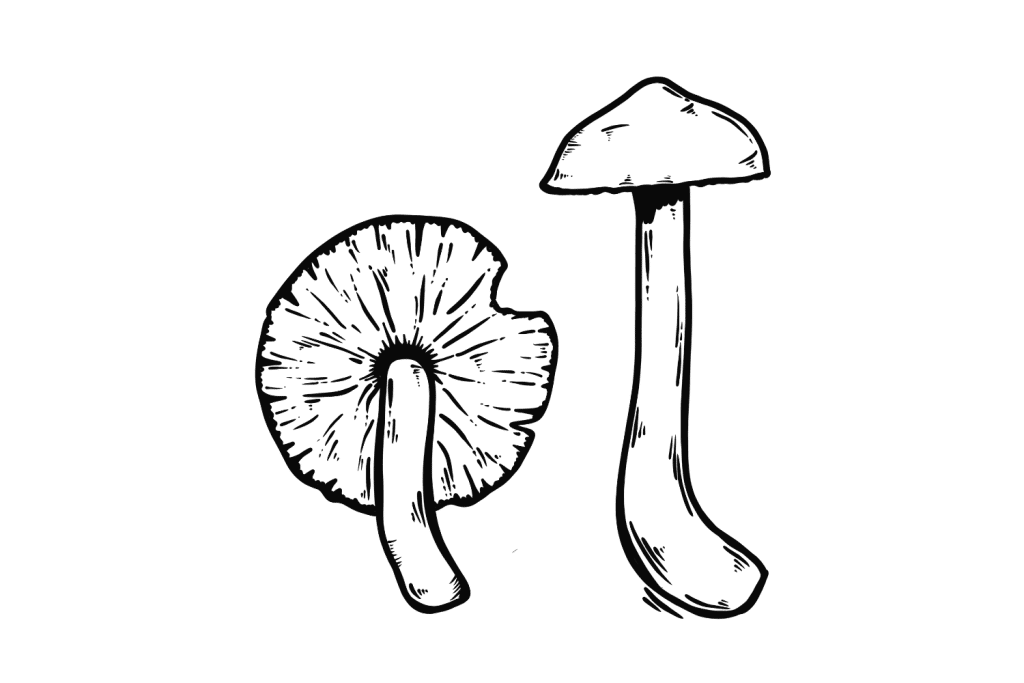
There hasn’t been a lot of study or analysis of this genus, so it’s likely many more species contain psilocybin and other psychoactive ingredients too.
Don’t attempt to wildcraft this species unless you’re 100% confident in your ability to differentiate from Galerina species. Even skilled mycologists have mistaken these species, and eating them could be fatal.
5. Inocybe
Inocybe is a large and diverse group of species spanning all different forms and variations. Of the more than 1400 species in the Inocybe genus, only three are confirmed to contain psilocybin.
Many of the members of this species are mycorrhizal fungi — which means they live symbiotically inside the roots of trees and plants. These species are integral to the health of the forest and serve as a sort of mycelial network— helping the forest communicate and distribute resources during times of drought or disaster.
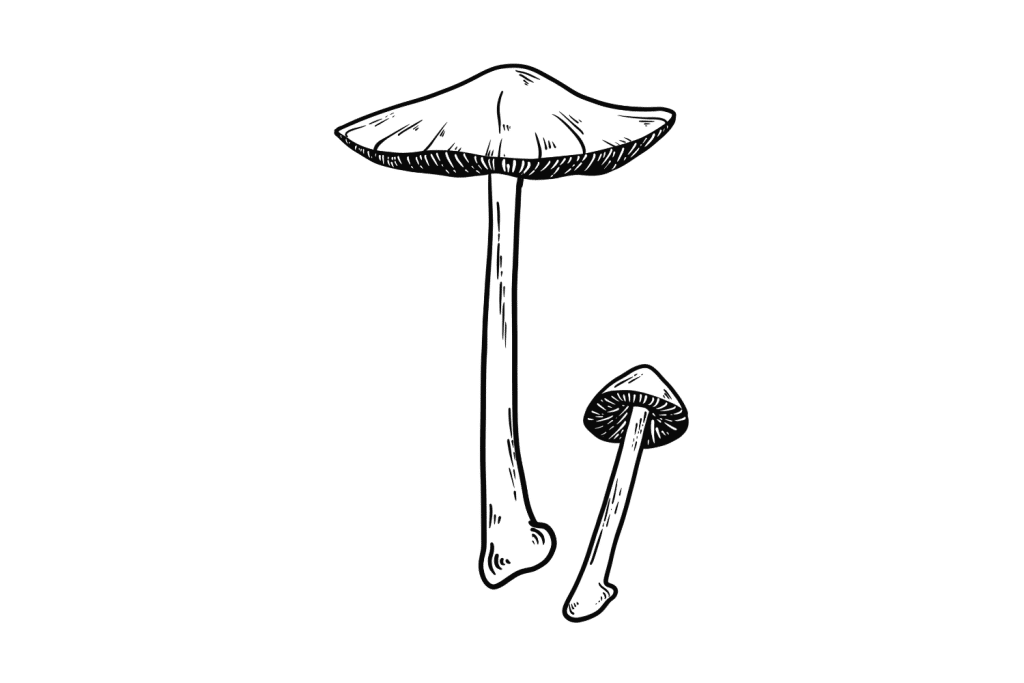
There are also a lot of potentially lethal members of this group which can make it dangerous to attempt to wildcraft the psilocybin mushroom species-containing members. For example, several species of Inocybe mushrooms contain muscarine — a toxic substance responsible for many fungi-related deaths around the world.
Inocybe species confirmed to contain psilocybin include:
- Inocybe aeruginascens
- Inocybe corydalina
- Inocybe calamistrata
Toxic Inocybe species include:
- Inocybe sororia
- Inocybe maculata
- Inocybe pudica
- Inocybe geophylla
6. Pluteus
Pluteus is another minor psilocybin-containing genus. Only a handful of the more than 300 species in this genus contain notable concentrations of psilocybin.
This group mainly consists of wood decomposers living on deadwood in old-growth forests.
A unique characteristic of this family is the presence of pink or light red colored spores.
Pluteus species confirmed to contain psilocybin or psilocin include:
- Pluteus villosus
- Pluteus cyanopus
- Pluteus glaucus
- Pluteus salicinus
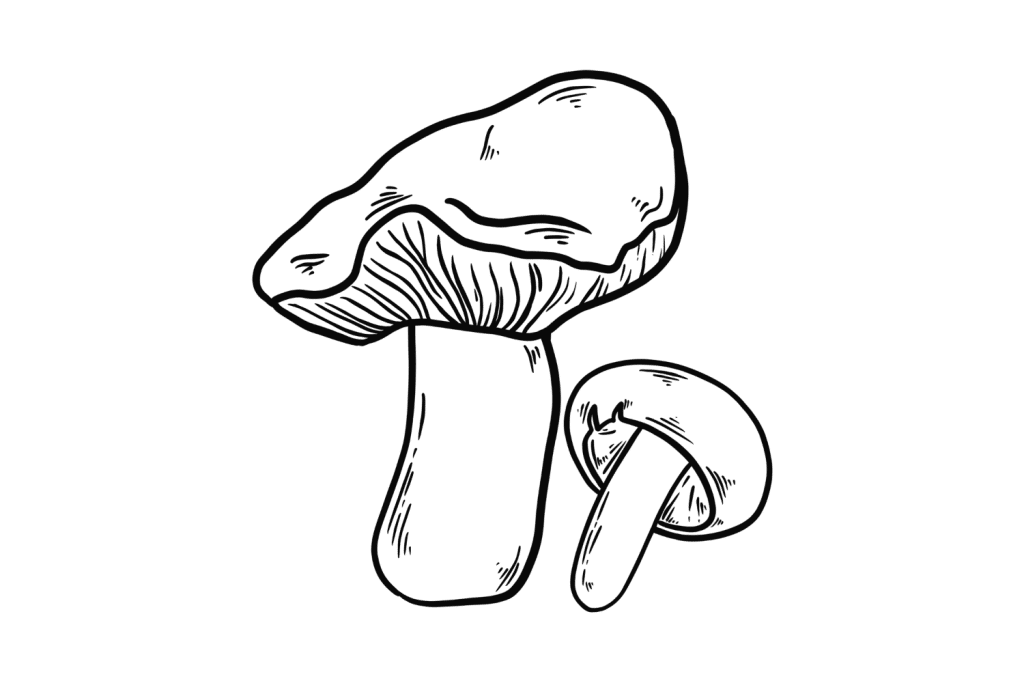
Other Species of Psychoactive Fungi
There are a handful of other fungi that are considered psychoactive or psychedelic that don’t rely on psilocybin or psilocin as the active ingredients.
It’s important to note that all of the additional psychoactive fungi on this list come with their fair share of dangers and aren’t recommended for recreational use.
1. Amanita muscaria
The common name for this mushroom is the Fly Agaric. Its distinct red cap with white spots is hard to miss. This mushroom is found throughout pop culture — it’s the powerup mushroom in Mario Brothers games, and there’s even an emoji for it! 🍄
The psychedelic effects of this mushroom are strange, to say the least.
It isn’t psychedelic the same way as magic mushrooms, LSD, DMT, or any other psychedelic. This mushroom is more of an oneirogen than a psychedelic. The effects are lucid and trippy. It’s more of a dream herb than anything else. It can be difficult to tell when you’re dreaming and when you’re awake.
This mushroom doesn’t contain any psilocybin, psilocin, or baeocystin. Instead, the active ingredients are ibotenic acid and muscimol. It works by stimulating acetylcholine receptors, which is the opposite effect of deliriant substances like DPH, datura, or mandrake.
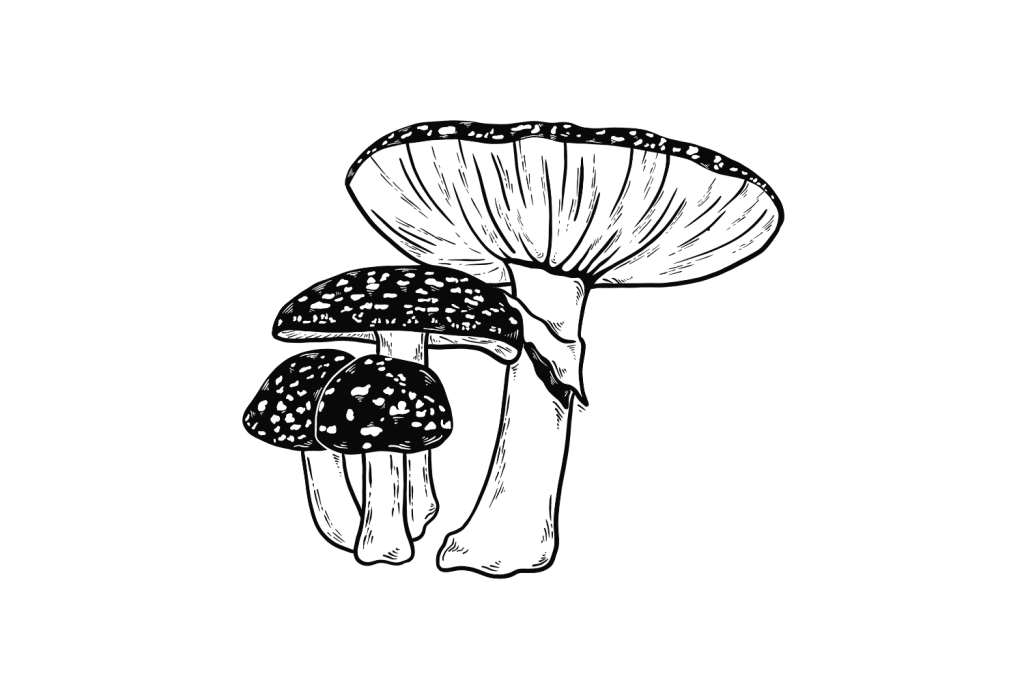
Tread cautiously with this mushroom — higher doses can be toxic. Even when used in what’s considered a “safe dose,” this mushroom is strongly sedative and can cause potentially dangerous side effects in susceptible individuals.
2. Claviceps spp.
Claviceps is a genus of ergot fungi that infect grains like wheat, barley, and rye. They produce a host of alkaloids with psychoactive effects.
Ergot poisoning (ergotism) happens when bread products are made from grains infected with the ergot fungus (usually Claviceps purpurea). The condition can be lethal, damaging blood vessels in the extremities, hallucinations, convulsions, mania, and eventually death.
LSD-25 (and other lysergamide psychedelics) are derived from ergotamine alkaloids. These compounds are some of the strongest psychedelics gram for gram on Earth — capable of inducing powerful psychedelic states with just 1/10th of a milligram (orally).
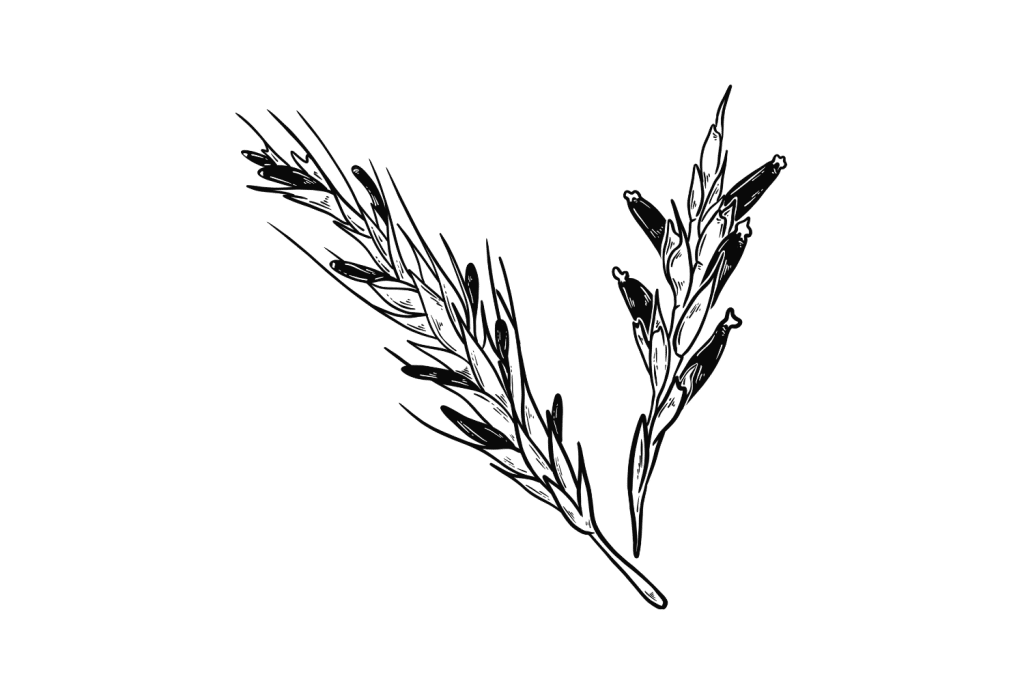
Many ergot alkaloids share similarities with the chemical structure and effects of psilocybin from magic mushrooms — but there are no Claviceps fungi that contain psilocybin directly.
psilocybin mushroom species Frequently Asked Questions
Here are some of the most common questions about magic mushrooms.
1. What’s the Strongest psilocybin mushroom species ?
The strongest psilocybin mushroom species in terms of total combined psilocybin and psilocin content is Psilocybe azurescens, followed by Psilocybe bohemica, then Psilocybe semilanceata.
With that said, it’s difficult to rank the potency of magic mushroom species because of how many variables are at play. One particular harvest of a magic mushroom could contain high concentrations of psilocybin and psilocin, while subsequent harvests may be virtually psilocybin-free.
Environmental factors such as the substrate the mushroom lives on, the time of the year, ambient temperature, and storage conditions can all dramatically affect the potency of magic mushrooms.
2. What’s the Most Common psilocybin mushroom species?
The most common species of magic mushroom worldwide is either Psilocybe cubensis or Psilocybe semilanceata.
Cubensis species tend to be more abundant in warmer regions, while semilanceata are more common in temperate regions.
Of course, the most common species of magic mushroom where you live could be something different entirely. Most mushrooms are generalists, able to survive in a wide range of microclimates — however, some are more specialized and will thrive in much greater numbers in specific regions of the world.
3. What’s the Easiest Magic Mushroom Species to Grow?
Psilocybe cubensis are the easiest and most forgiving species of magic mushrooms you can grow at home.
They’re not nearly as picky as most of the other species on this list and are able to live on a wide range of diets and environmental conditions. This is the main reason why these mushrooms are the standard option for psychedelic mushrooms.
Cubes can eat anything from manure to birdseed to coffee — just about any organic material can be used to grow Psilocybe cubensis mushrooms effectively. Of course, some substrates work better than others.
You can buy magic mushroom spores online. Most vendors sell a variety of Psilocybe cubensis options. Only a select few vendors sell Panaeolus species or culinary mushroom species like shiitake or oyster mushrooms.
4. Are psilocybin mushroom species Poisonous?
For the most part, no, magic mushrooms in the Psilocybe and Panaeolus genus’ are not poisonous. The most dangerous aspect of eating these mushrooms comes from misidentification. There are a lot of mushroom species that closely resemble magic mushrooms that are poisonous — especially in the Amanita or Galerina genus’.
With that said, it’s possible that some magic mushroom species in the Pluteus, Inocybe, Conocybe, or Gymnopilus genus contain toxic components such as muscarine in combination with psilocybin.
5. Is Baeocystin Psychoactive?
Baeocystin is an analog of psilocybin — which means it’s very closely related structurally.
Some early reports suggest baeocystin is psychoactive, but more recent studies on rats suggest no psychoactivity whatsoever.
The jury is still out on this one. There hasn’t been enough interest or scientific research to fully elucidate the psychoactive potential of this novel alkaloid.
In either case, the vast majority of psychedelic mushrooms contain so little baeocystin it’s unlikely to have any effect at the common doses used. The psilocybin and psilocin far outweigh any mild psychedelic potential of the baeocystin component.
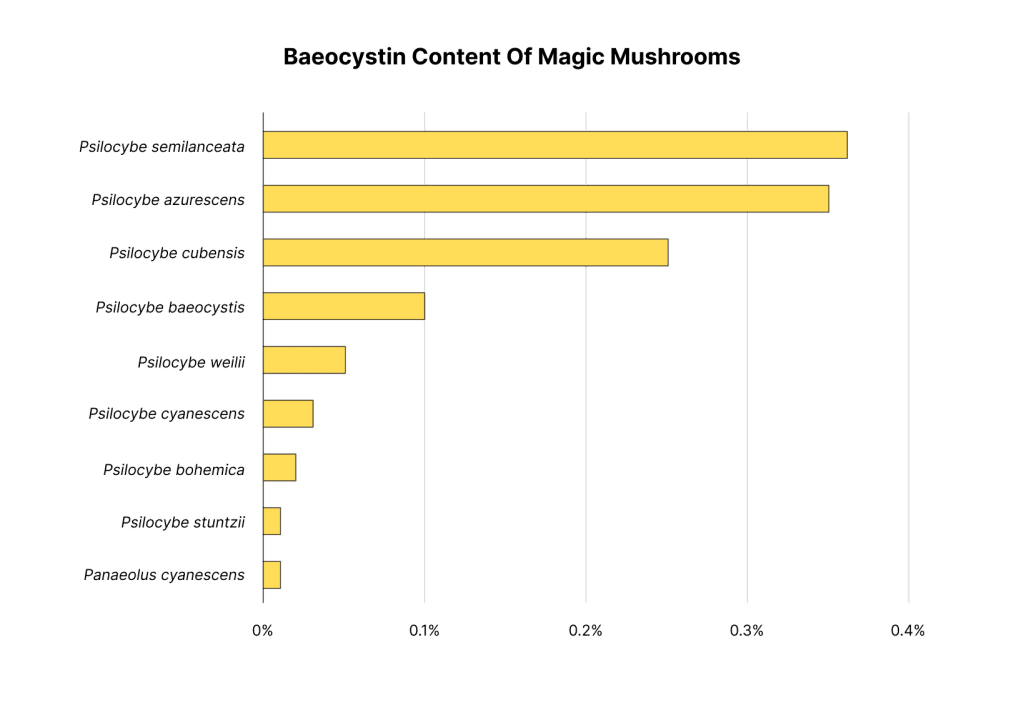
6. Is It Safe to Wildcraft psilocybin mushroom species ?
The most dangerous aspect of wildcrafting magic mushrooms is misidentification. The vast majority of magic mushrooms are small, brown, nondescript mushrooms. There are many species of poisonous mushrooms that fit the same description.
The Stametsian rule of thumb is that if a mushroom has gills, purplish to black-colored spores. And the flesh of the mushroom bruises a blue color when touched — it’s likely a psilocybin-containing mushroom.
There are no known psilocybin-containing mushrooms that are also toxic — but this doesn’t mean there aren’t any in existence. There are so many mushrooms we still don’t know anything about, so it’s possible there are some species that contain both psilocybin and toxic substances.
7. What Are Synthetic psilocybin mushroom species?
A compound by the name of 4-AcO-DMT is often referred to as synthetic magic mushrooms because it’s a prodrug of psilocin — the active ingredient in magic mushrooms.
4-AcO-DMT is structurally very similar to psilocybin and psilocin, and the effects are virtually indistinguishable. Some people prefer to use this substance because of its consistency in terms of dosage.
When you take a magic mushroom, you have no idea what dosage you’re actually getting because the potency of mushrooms varies from one batch to another.
With 4-AcO-DMT, you know precisely what dose you’re getting and what effects you can expect.
8. What psilocybin mushroom species is Used In Psychedelic-Assisted Psychotherapy?
Any psychoactive mushroom species is suitable for use in psychedelic-assisted psychotherapy. The only difference between them comes down to the dose.
With that said, most clinics and psychedelic facilitators use Psilocybe cubensis because of its low cost, consistency, and widespread availability.
There’s a lot of interest in using synthetic versions of psilocybin and psilocin as a therapeutic agent as well because it’s easier to use a precise, repeatable dosage.
There are a few companies working on synthetic psilocybin or synthetic psilocin directly — such as Compass Pathways. The problem is that these companies are attempting to patent and control the production of these molecules.
A better candidate is 4-AcO-DMT because the effects are identical to magic mushrooms, and nobody owns the patent for this molecule.
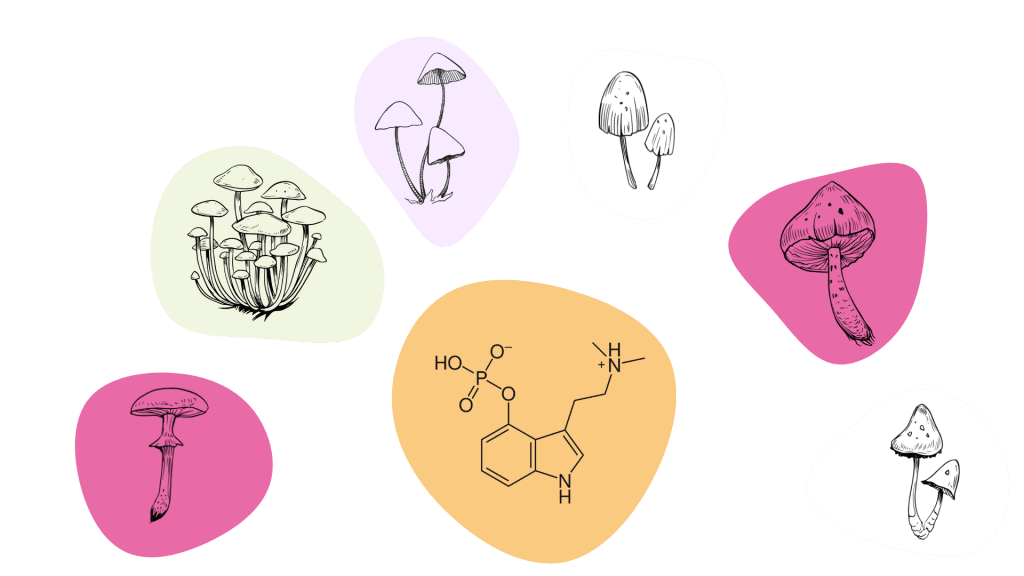
Key Takeaways: Which Mushrooms Contain Psilocybin?
The active ingredient in magic mushrooms, psilocybin, can be found in a surprising array of mushroom species. The largest genus of psilocybin mushrooms, by far, is Psilocybe, but there are also species of Panaeolus, Conocybe, Inocybe, Gymnopilus, and Pluteus that are psychoactive as well.
Some fungi have other psychedelic substances, such as ergotamine from Claviceps purpurea or ibotenic acid from Amanita muscaria.
The world of psilocybin mushroom species is still not well understood. There are a lot of species we know are psychoactive but haven’t been mapped out, and there are species s
